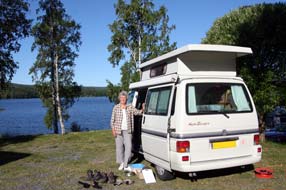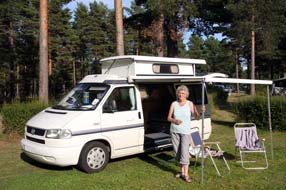|
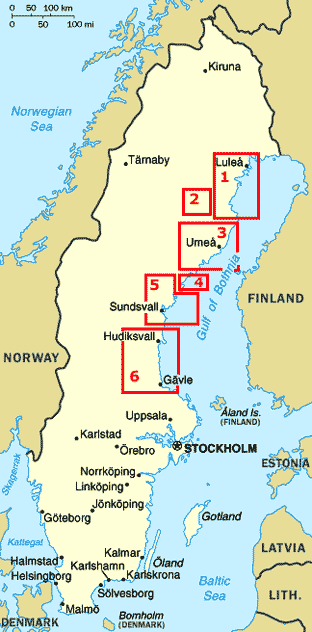 CAMPING
IN SWEDEN 2013 - south down the Bothnian Coast from Luleå, Piteå, Storforsen
Rapids, Skellefteå, Umeå, High Coast National Park, Sundsvall, Hudiksvall and Gävle: CAMPING
IN SWEDEN 2013 - south down the Bothnian Coast from Luleå, Piteå, Storforsen
Rapids, Skellefteå, Umeå, High Coast National Park, Sundsvall, Hudiksvall and Gävle:
Down the Kalix Valley to the Bothnian Coast
at Rörbäcks: having crossed the Arctic Circle southwards, we made our
way down the increasingly pastoral valley leaving now far behind the empty
wilderness forests of further north and crossed the wide Kalix River into the
little town of Överkalix to join the main E10 coming in from Kiruna and
Gällivare. Down the lower valley of the Kalixälven, we finally reached the head of
the Bothnian Gulf at Töre where the E10 merged with the E4 highway coming in
from the Finnish border at Haparanda. Turning off onto a narrow lane leading
down to
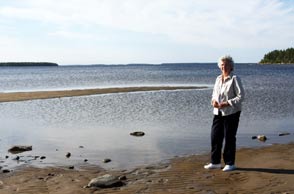 the coast, we found Rörbäcks Camping ranging over a headland among
shore-side pine woods; our beach-side pitch among the pines looked out across
the shallows of the Bothnian Gulf
(Photo 1 - Bothnian Gulf at Rörbäcks Camping). The afternoon sun was still bright, a breeze
off the sea kept any residual midges away, and fully ripe dwarf cornel red berries flourished alongside our pitch
(Photo 2 - Ripe berries of Dwarf Cornel - Cornus suecica). That evening, with the Midnight Sun
period now past, a late dusk settled and a full moon rose over the Baltic Sea
(Photo 3 - Full moon rising over the Bothnian Gulf). the coast, we found Rörbäcks Camping ranging over a headland among
shore-side pine woods; our beach-side pitch among the pines looked out across
the shallows of the Bothnian Gulf
(Photo 1 - Bothnian Gulf at Rörbäcks Camping). The afternoon sun was still bright, a breeze
off the sea kept any residual midges away, and fully ripe dwarf cornel red berries flourished alongside our pitch
(Photo 2 - Ripe berries of Dwarf Cornel - Cornus suecica). That evening, with the Midnight Sun
period now past, a late dusk settled and a full moon rose over the Baltic Sea
(Photo 3 - Full moon rising over the Bothnian Gulf).
|
Click on 6 highlighted areas of
map for
details of
the Bothnian coast |
 |
After a warm, balmy night we woke to a
beautiful morning with a clear sky; returning from the Arctic we revelled in the
warmth of a second summer. The bright sun shining across the shallow bay
sparkled across the water as we walked across the sandy foreshore to dip a toe
into the shallows of the Baltic Sea at its northernmost reach (see left). This was a truly
magnificent shore-side setting, especially on such a glorious morning
(Photo 4 - Rörbäcks Beach at northern tip of Bothnian Gulf).
South to the university-city and port of
Luleå: re-joining the E4 for the 50km drive to Luleå, we made good
progress south to turn off into the port-city at the head of the Bothnian Gulf,
finding a car park in the heart of the modern centre opposite Norra Hamn (North
Harbour) at the mouth of the Luleälven river which we had seen at an earlier
stage of its fluvial life up at Porjus. Luleå was originally founded in 1621 as
a trading settlement inland from the modern city's location on the coast. Its little harbour enabled the original colony to flourish through trade with
the hinterland. But with sea-levels falling due to post-glacial land-uplift, the original small harbour silted up and in 1649 the trading
centre moved closer to the coast to its present location. A handful of more
religious folk stayed put around the old church and the collection of church
huts continued in use now forming Gammelstad Church Town. The new Luleå
continued to develop as both a trading and ship-building centre during the early
19th century, and with the completion of the Malmbanan railway in 1888 linking
the Bothnian port to the iron ore mines at Gällivare and
Kiruna, Luleå's fortune really took off as an export port for the lucrative iron
ore trade. Today, the year-round ice-free
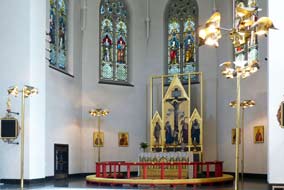 port of Narvik on the Norwegian coast
has taken over in importance, but the university city has become the high-tech industrial centre of
the north specialising in metallurgy. port of Narvik on the Norwegian coast
has taken over in importance, but the university city has become the high-tech industrial centre of
the north specialising in metallurgy.
A visit to Luleå: we set off to
walk through the trendy modern centre of Luleå to find the Domkyrkan. The
interior of the red-brick neo-Gothic cathedral, built in 1893 to replace an
earlier church destroyed in a city fire 6 years earlier, was devoid of
decoration and painted in cool light colour (see left). In now hot sunshine we walked
westwards for a couple of blocks through the quiet streets to find the Norrbottens Museum to find out more about the region's history. The displays of
historical photos showed many of the places we had visited on our journey north;
the gallery supposedly documenting the impact of the disastrous war with Russian
which resulted in total loss of Finland in 1809 and redrawing of the border along
the Muonio River lost much of its value through poor translation; displays
illustrating the annual cycle of migratory reindeer herding was mildly
interesting, but the Museum's most promising feature, films relating
Norrbottens's history, were not showing. All in all the county museum which had
held such promise was something of a disappointment; fortunately entry had been
free .
The Luleå iron ore terminal: Luleå
spreads across the width of a peninsula in the estuary of the Luleälven river
and we walked across to the South Harbour hoping to see something of the LKAB
iron ore terminal at the eastern end of the Malmbanan railway as we had seen it
at its western end at Narvik. In the distance across the far side of the wide
bay, we could just make out lines of hopper wagons and boats moored at the quay
where the map showed the railway line to lead. But even a long walk around the
harbour-side brought us no closer. Before leaving the city therefore, we decided
to drive around to an industrial area on the far side of the bay in an attempt
to gain a closer look at the Luleå ore terminal which clearly
 was now a less
significant port for ore shipment than ice-free Narvik; the port of Luleå at the
head of the Bothnian Gulf is totally blocked by ice in winter making ore
shipment seasonal as well as involving a longer sea voyage from the Baltic. We
drove around a long inner ring-road eventually crossing the railway line where
empty wagons filled the sidings. Beyond this, we could see the huge industrial
outline of a steelworks with its familiar LKAB sign bearing the twin mountain
logo of Luossavarre and Kirunavare AB. We followed the road to its end at a
security gate in a semi-derelict area cleared of its former buildings, where
long overhead conveyors led down to the harbour-side. Security fencing among
trees blocked further view of any dock-side loading, and expecting at any moment
security men to appear demanding explanation of our unauthorised presence on
company property, we returned along the lane to where we could see the gigantic
steelworks beyond the overhead conveyors near the main entrance to the
industrial complex. At a nearby railway bridge a sign by the lines of
hopper-wagons announced the steelworks as LKAB's experimental blast furnace
(see right) where the company worked with steel-making clients on smelting and refining
techniques
(Photo 5 - LKAB steel works at Luleå iron ore terminal). Satisfied that this was the limit of possible views of LKAB's iron
ore terminal, we returned to the city to re-stock with provisions at an ICA
hypermarket. was now a less
significant port for ore shipment than ice-free Narvik; the port of Luleå at the
head of the Bothnian Gulf is totally blocked by ice in winter making ore
shipment seasonal as well as involving a longer sea voyage from the Baltic. We
drove around a long inner ring-road eventually crossing the railway line where
empty wagons filled the sidings. Beyond this, we could see the huge industrial
outline of a steelworks with its familiar LKAB sign bearing the twin mountain
logo of Luossavarre and Kirunavare AB. We followed the road to its end at a
security gate in a semi-derelict area cleared of its former buildings, where
long overhead conveyors led down to the harbour-side. Security fencing among
trees blocked further view of any dock-side loading, and expecting at any moment
security men to appear demanding explanation of our unauthorised presence on
company property, we returned along the lane to where we could see the gigantic
steelworks beyond the overhead conveyors near the main entrance to the
industrial complex. At a nearby railway bridge a sign by the lines of
hopper-wagons announced the steelworks as LKAB's experimental blast furnace
(see right) where the company worked with steel-making clients on smelting and refining
techniques
(Photo 5 - LKAB steel works at Luleå iron ore terminal). Satisfied that this was the limit of possible views of LKAB's iron
ore terminal, we returned to the city to re-stock with provisions at an ICA
hypermarket.
A visit to Luleå's Gammelstad Church Town:
before heading south, we drove out along Route 97 to find the Gammelstad Church
Town some 5 kms up river on the site of the Luleå's 17th century foundation as a
trading post. Turning off from the highway through a chaos of road works, the
gates of the level-crossing where the Malmbanan comes in from the north were
closed and an ore train pulled by one of the huge electric locos passed through
on its way to the terminal we had just seen. At the end of the lane, we reached
the Old Church surrounded by the red-painted wooden cottages of the Gammelstad
Church Town. The original foundation of a church and encouragement of Swedish
settlers to colonise the empty
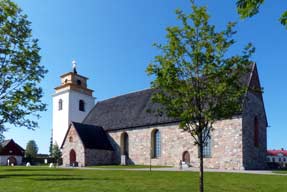 northern lands had been intended by the Swedish
Crown to counter the increasing influence of Imperial Russia. After the break
with Catholicism in 1527, the Swedish clergy were determined to enforce the
fundamentalist Lutheran religion and in 1681 church attendance was made
compulsory by law. The problem in the north was that the colonist Swedish
population and indigenous Sámi were spread over remote distances of the interior
making weekly church attendance impossible. Settlers from the
farmsteads along the river valleys leading into the distant interior were
obliged to attend northern lands had been intended by the Swedish
Crown to counter the increasing influence of Imperial Russia. After the break
with Catholicism in 1527, the Swedish clergy were determined to enforce the
fundamentalist Lutheran religion and in 1681 church attendance was made
compulsory by law. The problem in the north was that the colonist Swedish
population and indigenous Sámi were spread over remote distances of the interior
making weekly church attendance impossible. Settlers from the
farmsteads along the river valleys leading into the distant interior were
obliged to attend church at Luleå and a large township of church houses grew up
around the church. The trading centre soon became a meeting place
for merchants from the Bothnian Gulf coastal region and settlers from outlying
parts of interior attending church. When the trading centre moved to the new
harbour closer to the river's mouth in 1649, the Church Town remained here
providing shelter for those travelling for their compulsory church attendance.
The present stone church was built originally in the 14th century (see left), its size and
lavish decoration testimony to the region's prosperity based on trade in furs
and salmon fish. But the farming colonisers formed the largest group of the huge
parish which extended onto the mountains and northwards to what is now the
Finnish border. Even during the 20th century, Gammelstad retained its historical
integrity and today 408 cottages survive, crammed together along narrow
alleyways, all still privately owned and with right of occupancy restricted to
those born in Gammelstad. Now the largest of Sweden's surviving church towns,
the Luleå Gammelstad has UNESCO World Heritage status. church at Luleå and a large township of church houses grew up
around the church. The trading centre soon became a meeting place
for merchants from the Bothnian Gulf coastal region and settlers from outlying
parts of interior attending church. When the trading centre moved to the new
harbour closer to the river's mouth in 1649, the Church Town remained here
providing shelter for those travelling for their compulsory church attendance.
The present stone church was built originally in the 14th century (see left), its size and
lavish decoration testimony to the region's prosperity based on trade in furs
and salmon fish. But the farming colonisers formed the largest group of the huge
parish which extended onto the mountains and northwards to what is now the
Finnish border. Even during the 20th century, Gammelstad retained its historical
integrity and today 408 cottages survive, crammed together along narrow
alleyways, all still privately owned and with right of occupancy restricted to
those born in Gammelstad. Now the largest of Sweden's surviving church towns,
the Luleå Gammelstad has UNESCO World Heritage status.
Surprised at the few numbers of other visitors,
we walked up to the church which was certainly the most ornate seen in Sweden
with surviving 15th century chancel wall frescoes, a sumptuously carved and
gilded wooden altar-piece made in Antwerp at the end of the 15th century, and an
ornately decorated Baroque pulpit
(see right) (Photo 6 - Gammelstad Old Church near to Luleå). The size of the tithe barn just behind the
church was further indication of parish prosperity. In pleasantly warm afternoon
sunshine, we spent a relaxing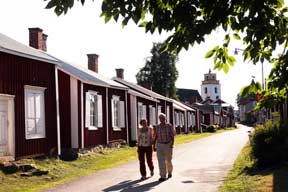 hour wandering around the lanes of tightly packed
red-painted little wooden huts
(Photos 7 and 8 - Wandering the lanes of Gammelstad Church Town), one of which was being re-painted with genuine Falu Rödfärg wood preservative whose manufacture from copper mining waste rock
we had seen many weeks ago at Falun. Beyond the church, we walked down Gamla
Hamngatan (see left) to what had been the site of the original harbour. The bay of Gammelstadsviken which originally gave access to the sheltered port is now
totally sealed off from the Luleälven estuary by land-uplift and all that
remained now was a tiny brook. hour wandering around the lanes of tightly packed
red-painted little wooden huts
(Photos 7 and 8 - Wandering the lanes of Gammelstad Church Town), one of which was being re-painted with genuine Falu Rödfärg wood preservative whose manufacture from copper mining waste rock
we had seen many weeks ago at Falun. Beyond the church, we walked down Gamla
Hamngatan (see left) to what had been the site of the original harbour. The bay of Gammelstadsviken which originally gave access to the sheltered port is now
totally sealed off from the Luleälven estuary by land-uplift and all that
remained now was a tiny brook.
An unsavoury campsite overwhelmed by traffic noise: returning to
the E4 highway, we crossed the wide Luleälven river to begin the drive south to
find tonight's campsite close to Piteå. Only 2 days earlier we had been in
tundra wastes near to Karesuando; now we were passing through almost
southern-looking farming countryside. It was not a happy feeling heading south.
Reaching Ladrike Camping and having to turn left off the highway across the busy
north-bound carriageway into the campsite entrance, it was immediately clear
that it was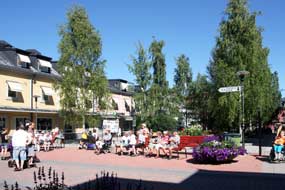 overwhelmed with traffic noise. The offensively rude
'take-it-or-leave-it' attitude at reception, together with an over-priced
250kr/night cost for a basic site, overwhelmed by traffic noise and with wholly
inadequate and run-down facilities, was symptomatic of holiday-making Bothnian
Coast campsites, Sweden's least attractive region during the summer months,
memorable for all the wrong reasons! overwhelmed with traffic noise. The offensively rude
'take-it-or-leave-it' attitude at reception, together with an over-priced
250kr/night cost for a basic site, overwhelmed by traffic noise and with wholly
inadequate and run-down facilities, was symptomatic of holiday-making Bothnian
Coast campsites, Sweden's least attractive region during the summer months,
memorable for all the wrong reasons!
The charming small town of Piteå: a
few kms down the E4 highway, we turned off into the little town of Piteå passing
the huge power station and chemical plant which dominated the approach road.
Like Luleå, Piteå is another of those former coastal trading colonies whose
original foundation, established with its church town just inland on a
sheltered former bay at Öjebyn, had had to be relocated closer to the coast as
the land rose and the harbour silted up. The modern town of Piteå is now sited
on a peninsula close to the Bothnian Gulf and we managed to find street parking
close to the centre for a stroll around the pedestrianised streets of this
pleasantly modest town (see right) (Photo 9 - Lunch-time at Piteå).
A visit to the spectacular Storforsen Rapids:
a sign at the E4 roundabout on the outskirts of Piteå pointed 50kms inland
towards Älvsbyn with Storforsen a further 30km. This persuaded us to make a
diversion westwards to investigate these spectacular
 rapids on the Piteälven
river and camp up there tonight before resuming our southward journey
tomorrow. Turning west onto Route 374 and passing through Piteå's original
site at Öjebyn with its surviving church town, it took only a half hour to reach
the small town of Älvsbyn where we turned off across the wide Piteå River for
diesel and a provisions shop. With our return to warm summer weather after
leaving the Arctic, we also bought charcoal to resume barbecuing in the
evenings. On the edge of the town we found Selholmens rapids on the Piteälven
river and camp up there tonight before resuming our southward journey
tomorrow. Turning west onto Route 374 and passing through Piteå's original
site at Öjebyn with its surviving church town, it took only a half hour to reach
the small town of Älvsbyn where we turned off across the wide Piteå River for
diesel and a provisions shop. With our return to warm summer weather after
leaving the Arctic, we also bought charcoal to resume barbecuing in the
evenings. On the edge of the town we found Selholmens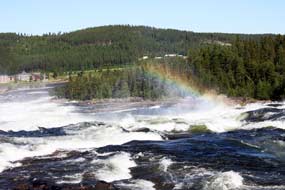 Camping, a small local
campsite pleasantly terraced up the banks of the river where we should return
this evening. Route 374 westwards was a good road and back in comfortably
forested terrain, we soon reached the lake where the Piteälven turns a sharp 90°
after descending the mighty Storforsen rapids. A side lane ended at an enormous
and almost full car park and at the information centre we were able to buy a
detailed map of the nature walk along the wooden board-walk which ran the length
of the rapids. The Piteälven is one of Sweden's 4 remaining uncontrolled
rivers, whose natural environment is protected by law from the intrusion of
hydro-electric generation exploitation. The rapids at Storforsen are the
greatest natural white-water rapids in the Nordic countries and among Europe's
largest with a total drop of 82m over their 5km course at a point where the
river has over aeons gouged out a channel in the hard granite bed rock. Along
the final and most spectacular 600m, the rapids drop some 50m before the river
resumes its normally placid onward flow. The nature reserve includes sturdy
wooden walk-ways alongside this final 600m section of the falls enabling close
viewing of this spectacular natural phenomenon (see left). Camping, a small local
campsite pleasantly terraced up the banks of the river where we should return
this evening. Route 374 westwards was a good road and back in comfortably
forested terrain, we soon reached the lake where the Piteälven turns a sharp 90°
after descending the mighty Storforsen rapids. A side lane ended at an enormous
and almost full car park and at the information centre we were able to buy a
detailed map of the nature walk along the wooden board-walk which ran the length
of the rapids. The Piteälven is one of Sweden's 4 remaining uncontrolled
rivers, whose natural environment is protected by law from the intrusion of
hydro-electric generation exploitation. The rapids at Storforsen are the
greatest natural white-water rapids in the Nordic countries and among Europe's
largest with a total drop of 82m over their 5km course at a point where the
river has over aeons gouged out a channel in the hard granite bed rock. Along
the final and most spectacular 600m, the rapids drop some 50m before the river
resumes its normally placid onward flow. The nature reserve includes sturdy
wooden walk-ways alongside this final 600m section of the falls enabling close
viewing of this spectacular natural phenomenon (see left).
As we started down the path from the car park, the
air was filled with the sound of rushing water and the start of the board-walk
passed across the now dry rocks and pools of the Döda Fallet (Dead Falls), the
former natural widely spreading course of the river. When the Piteälven was used for floating cut timber downstream, river channel had been
artificially narrowed into a float-way forming the present course and leaving
the water-smoothed rocks of its former course dry. On reaching this area, we
discovered the reason for the full car park: the smooth rocks and pools
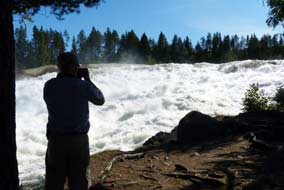 of the
Dead Falls were now a Blackpool Beach of obese sunbathing bodies sprawled
totally oblivious to the wonders of nature passing with 200m. Thankful that the board-walk alongside the rapids was largely spared this unsavoury intrusion, we
hurried past. With due appreciation of the walk-way's sturdy construction we
stood in amazement looking directly over the point at which the mighty river
tumbled over the brink of the rapids, surging and boiling in foaming fury down
its white-water passage (Photo 10 - Board-walk alongside Storforsen Rapids). We followed the board-walk down to where the rapids
dropped more steeply, the foaming spray creating rainbows in the bright
sunshine (see right) (Photo 11 - Rainbow over Storforsen Rapids), and of the
Dead Falls were now a Blackpool Beach of obese sunbathing bodies sprawled
totally oblivious to the wonders of nature passing with 200m. Thankful that the board-walk alongside the rapids was largely spared this unsavoury intrusion, we
hurried past. With due appreciation of the walk-way's sturdy construction we
stood in amazement looking directly over the point at which the mighty river
tumbled over the brink of the rapids, surging and boiling in foaming fury down
its white-water passage (Photo 10 - Board-walk alongside Storforsen Rapids). We followed the board-walk down to where the rapids
dropped more steeply, the foaming spray creating rainbows in the bright
sunshine (see right) (Photo 11 - Rainbow over Storforsen Rapids), and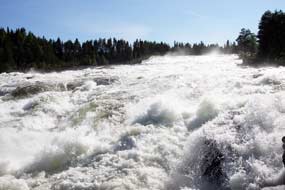 from under the pines on the river bank, took endless photos trying
to capture the essence of this spectacular if terrifying embodiment of surging
water power taking place in front of us (Photo 12 - Storforsen Rapids). We later learnt at the information
centre that the board-walk had been replaced 2 years ago after the mighty river,
running in Spring time spate had destroyed the earlier one. During winter, the
entire rapids freeze over. The bitterly cold air is whipped by the foaming water
deep into the river causing it to freeze not on the surface but at the bottom
where ice retards the water flow creating an ice dam; this forces the water out
sideways into the surrounding forest freezing over trees and bushes. Such
freezing over of the rapids in the depths of winter must be an even more
fearsome sight. Mesmerised by the surging water of the rapids, the roaring of
which filled the air at such close quarters (see right), we returned upstream, re-crossing
the water-smoothed rocks and swirl holes of the Dead Falls. The visit to
Storforsen had been a memorable experience, certainly worth the drive up from
the coast. Back at Route 374, leftwards was signed for Jokkmokk, and we would
happily have returned to Lapland rather than face the over-priced campsites of
the Bothnian coast overpopulated with holiday-makers. But with some regrets we
turned right for the return drive to Älvsbyn from under the pines on the river bank, took endless photos trying
to capture the essence of this spectacular if terrifying embodiment of surging
water power taking place in front of us (Photo 12 - Storforsen Rapids). We later learnt at the information
centre that the board-walk had been replaced 2 years ago after the mighty river,
running in Spring time spate had destroyed the earlier one. During winter, the
entire rapids freeze over. The bitterly cold air is whipped by the foaming water
deep into the river causing it to freeze not on the surface but at the bottom
where ice retards the water flow creating an ice dam; this forces the water out
sideways into the surrounding forest freezing over trees and bushes. Such
freezing over of the rapids in the depths of winter must be an even more
fearsome sight. Mesmerised by the surging water of the rapids, the roaring of
which filled the air at such close quarters (see right), we returned upstream, re-crossing
the water-smoothed rocks and swirl holes of the Dead Falls. The visit to
Storforsen had been a memorable experience, certainly worth the drive up from
the coast. Back at Route 374, leftwards was signed for Jokkmokk, and we would
happily have returned to Lapland rather than face the over-priced campsites of
the Bothnian coast overpopulated with holiday-makers. But with some regrets we
turned right for the return drive to Älvsbyn
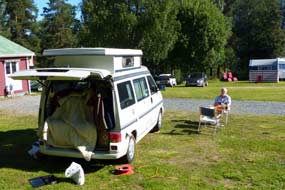 glancing as we passed at the full
length of Storforsen rapids where it descended to the lake for the Piteälven to
continue down valley. glancing as we passed at the full
length of Storforsen rapids where it descended to the lake for the Piteälven to
continue down valley.
Selholmens Camping at Älvsbyn, a truly
delightful campsite: the well-surfaced Route 374 enabled us to reach Älvsbyn
within an hour to cross the now wide and placidly flowing Piteälven to find Selholmens
Camping. Älvsbyn is set at the point where Route 94, the main cross-country road
from Luleå on the Bothnian coast to Arvidsjaur and Arjeplog and on to Norway
crosses the Piteälven river. Along with farming, fishing and timber, Älvsbyn
with a population of 8,000 has other industrial claims to fame: Älvsbyhus is
Scandinavia's largest manufacturer of prefabricated wooden houses seen all
across the country, and of course painted with Falun Red preservative. On the outskirts of the town overlooking the here tranquil river
we were welcomed by the family who keep the campsite and settled in on one of
the flat, grassy camping areas terraced up the steep river bank to enjoy the
late afternoon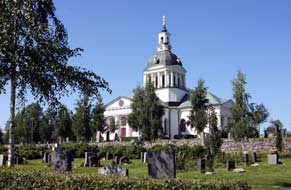 sunshine
(see left). As a further indication of this lovely little
campsite's hospitality, the owner's wife came round with a jug of coffee and
tray of home-made cakes. On a beautiful, still evening, we sat looking out over
the river as the sun dipped behind the trees. This was a truly delightful
campsite with a wood-fired sauna included in the price. sunshine
(see left). As a further indication of this lovely little
campsite's hospitality, the owner's wife came round with a jug of coffee and
tray of home-made cakes. On a beautiful, still evening, we sat looking out over
the river as the sun dipped behind the trees. This was a truly delightful
campsite with a wood-fired sauna included in the price.
South to Skellefteå: on a warm and
sunny morning, we returned along Route 374 to re-join the E4 highway near Piteå,
the terrain changing from empty forest to more cultivated pastoral land as we
approached the coast. The E4 was busier this morning but sections of
dual-carriageway enabled rapid progress south with the road passing close to the Bothnian Gulf along the forested coastal plain. Within an hour we were
approaching Skellefteå,
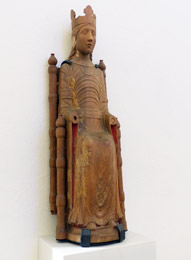 turning off through the suburbs to park under shady
trees by the domed neo-Classical parish church (see right). Swedish colonists had settled at
the mouth of the Skellefteälven river from the 14th century and a wealthy
trading settlement developed here centred around the parish church built
originally in 1324. The original wooden church was replaced by a larger stone
structure in 1507, the Gothic ogival arches of which can still be seen in the
sacristy of the modern neo-Classical church which was built in 1800 as the
parish grew in size. As at Luleå, a church town (kyrkstad) developed at Bonnstan
next to Skellefteå church with a collection of wooden huts where the travelling
parishioners could spend the night after sitting through lengthy Lutheran
sermons before returning to their distant farms. turning off through the suburbs to park under shady
trees by the domed neo-Classical parish church (see right). Swedish colonists had settled at
the mouth of the Skellefteälven river from the 14th century and a wealthy
trading settlement developed here centred around the parish church built
originally in 1324. The original wooden church was replaced by a larger stone
structure in 1507, the Gothic ogival arches of which can still be seen in the
sacristy of the modern neo-Classical church which was built in 1800 as the
parish grew in size. As at Luleå, a church town (kyrkstad) developed at Bonnstan
next to Skellefteå church with a collection of wooden huts where the travelling
parishioners could spend the night after sitting through lengthy Lutheran
sermons before returning to their distant farms.
T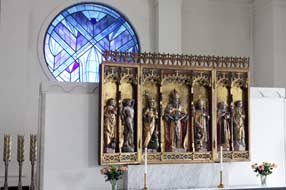 he huge, white-painted neo-Classical church
parish (Landskyrka), its large dome supported by 4 sturdy Doric columns on each
of the 4 sides, stood out starkly on the hillside above the Skellefteälven river
on the modern town's western outskirts (Photo 13 - Parish church (Landskyrka) at Skellefteå). The interior had been redesigned in the
1960s with a beautiful modern blue-stained glass rose window inspired by a mill
wheel from the island of Öland added at the east end (see right). But the church's prime
treasures was a collection of medieval carved wooden sculptured artwork of
saints and madonnas now restored to their glory in a small chapel behind the
altar. The pride of the collection was the statuette of the Skellefteå Madonna,
one of few preserved Romanesque images of the Virgin, carved from walnut wood in
Northern Germany in the 12th century (see left). The Child was missing, as were the arms
and hands on all the statuettes; the most likely explanation was their
deliberate removal to allow the carvings to be hidden in a wall cavity from
anti-Catholic vandalism after the State's conversion to puritanical Lutheranism.
The huge graveyard surrounding the church was beautifully tended with neatly
cropped turf and carefully raked gravel pathways. We walked down the lane to
where the Lejonströmsbron wooden bridge dating from 1737 crossed the
Skellefteälven (Photo 14 - 1737 Lejonströmsbron spanning the Skellefteälven). One he huge, white-painted neo-Classical church
parish (Landskyrka), its large dome supported by 4 sturdy Doric columns on each
of the 4 sides, stood out starkly on the hillside above the Skellefteälven river
on the modern town's western outskirts (Photo 13 - Parish church (Landskyrka) at Skellefteå). The interior had been redesigned in the
1960s with a beautiful modern blue-stained glass rose window inspired by a mill
wheel from the island of Öland added at the east end (see right). But the church's prime
treasures was a collection of medieval carved wooden sculptured artwork of
saints and madonnas now restored to their glory in a small chapel behind the
altar. The pride of the collection was the statuette of the Skellefteå Madonna,
one of few preserved Romanesque images of the Virgin, carved from walnut wood in
Northern Germany in the 12th century (see left). The Child was missing, as were the arms
and hands on all the statuettes; the most likely explanation was their
deliberate removal to allow the carvings to be hidden in a wall cavity from
anti-Catholic vandalism after the State's conversion to puritanical Lutheranism.
The huge graveyard surrounding the church was beautifully tended with neatly
cropped turf and carefully raked gravel pathways. We walked down the lane to
where the Lejonströmsbron wooden bridge dating from 1737 crossed the
Skellefteälven (Photo 14 - 1737 Lejonströmsbron spanning the Skellefteälven). One
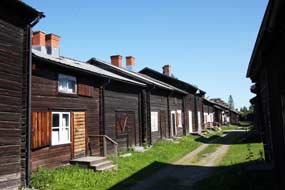 of the oldest and longest wooden bridges in Sweden, it had
been the site of a skirmish between Swedes and Russians in the war of 1741 and
still carries modern traffic, albeit one-way controlled by traffic-lights. of the oldest and longest wooden bridges in Sweden, it had
been the site of a skirmish between Swedes and Russians in the war of 1741 and
still carries modern traffic, albeit one-way controlled by traffic-lights.
From below the graveyard, a path lined with wild
raspberries bushes led to a small suspension foot-bridge over to the
river-island of kyrkholmen. Here locals gathered and children played at a summer
café. The path continued along the river bank to steps leading up into the heart
of the Bonnstan church town of 392 log-constructed wooden cottages clearly still
occupied (see left). We wandered along the alleyways where many of the residents sat
outside their huts in the afternoon sunshine. We assumed that some kind of trust
regulates the kyrkstad since the owners are forbidden to modernise the huts or
even install electricity. We returned along to the
church and queued at the lights to cross the wooden bridge to drive past the
modern centre of Skellefteå, now a town of some 30,000 inhabitants with gold
mining, electronics and computing as the main employing industries. After a
provisions stock-up at a Co-op Konsum in the southern outskirts, we resumed our
journey south on the E4 reaching tonight's campsite Lufta Camping just south of
Robertsfors after a half hour's drive. our
journey south on the E4 reaching tonight's campsite Lufta Camping just south of
Robertsfors after a half hour's drive.
A rest day at Lufta Camping: the campsite spread over a wooded
hillock was quite full of holiday-making caravans but we managed to find a
reasonably quiet corner facing the western sun with a friendly Norwegian/Finnish
couple as neighbours. Although low in the sky, the sun was still hot and this
evening the temperature in the shade was almost 30°C. Our neighbours came over
to chat: he had been a seafarer most of his life and spoke excellent English.
Now retired this lovely couple had settled near Linköping and insisted we call
in for coffee when we passed that way later in August. Later he came over with
his newspaper to show us the report of the birth of a future King George VII; he
seemed bemused over our indifference! We were far more content to watch the sun
dipping with a ruddy glow over the hillside, looking forward to a day in camp
tomorrow. We woke to another beautiful sunny morning and sat out for breakfast
under the shade of trees in temperatures of 34°C (see right). We spent a restfully
productive day working on our next web edition and reading up on the next phase
of the trip at the High Coast, and barbecued supper enjoying the soft, low
evening sunlight as shadows lengthened.
South to Umeå: after some rain and
thunderstorms in the early hours, the sky gradually cleared this morning to give
another fine day. Traffic was less busy on a Saturday morning for our 70km drive
down the E4 and within an hour we were approaching the outskirts of Umeå,
Northern Sweden's largest city with 116,000 inhabitants. Historically the city
was founded in 1622 by King Gustav II Adolfus and developed as a trading centre
and port at the mouth of the rivers Vindelälven and Umeälven which merge just
upstream from the city. But in 1888 Umeå suffered a devastating fire which
destroyed most of its buildings leaving 2/3 of the then 3,000 population
homeless. The city was quickly rebuilt with 2 wide esplanades as fire breaks as
insurance against future fire damage. To give a distinctive air to the new city,
all the streets were planted with birch trees and even today the city council
provides birch saplings free of
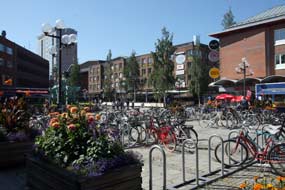 charge for residents to plant giving Umeå the
title City of Birch Trees. Today as a university-city with some 30,000 students,
it is demographically a young population with an average age of 37.5 years. The
presence of Norrland University with its teaching hospital attracts people to
the city. Innovative companies in the fields of biotechnology, power engineering
and IT have established themselves here making Umeå a dynamic and fast-growing
region. charge for residents to plant giving Umeå the
title City of Birch Trees. Today as a university-city with some 30,000 students,
it is demographically a young population with an average age of 37.5 years. The
presence of Norrland University with its teaching hospital attracts people to
the city. Innovative companies in the fields of biotechnology, power engineering
and IT have established themselves here making Umeå a dynamic and fast-growing
region.
With impressive precision, our satnav guided us
into the city centre and with traffic remarkable light we easily found parking
just 300m from the central square. At the TIC we enquired about campsites, but
there seemed no alternative to the ghastly, over-priced Umeå First Camp
over-populated with holiday-makers. Others down the coast were likely to be
equally expensive and over-crowded; it was a depressing prospect. From the TIC
we walked along past the ice-cream stall and birch trees of Renmarkstorget.
Local people gathered in the flower-lined square enjoying the morning sunshine
at this attractive setting in the modern city centre (see left) (Photo 15 - Birch trees at Renmarkstorget in Umeå). Along at the central
square of Rådhustorget, other locals were sitting on benches eating ice-creams
by the town-hall (see right). This had been built in the late 19th century with its main
entrance facing south towards the river where the city's port was the usual
point of arrival. When the railway reached Umeå from Stockholm in the first
decade of the 20th century, and the river-port silted up, a new entrance to the
town-hall had to be created on the north side facing the railway station along Rådhus-esplanaden where visitors now arrived. On our visit today, what had once
been a grand boulevard from the station was entirely blocked by building works
and tower-cranes overshadowed the town-hall. We walked down towards the Umeälven where,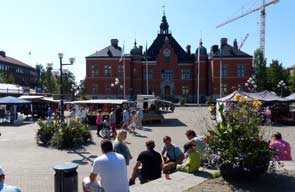 close to its estuary, the river flowed sluggishly wide. But instead of
the expected attractive riverside gardens, the entire embankment was blocked off
by unsightly building works. Away from this eyesore, we walked to find Umeå's
parish church overlooking the river. The original church built in the mid-17th
century was razed by the Russian army in the 1721 Great Northern War invasion.
The 1725 replacement wooden church was destroyed by fire on Christmas Eve 1887
and the present Neo-Gothic red-brick church consecrated in 1894. Back past
city-centre shops, we walked along the river embankment towards the Gamla Bron;
built in 1863, old it may be but far from attractive. Back through the quiet
city centre, we certainly had not seen Umeå and the banks of the Umeälven at
their best with all the intrusive building work, and did not recall noticing any
of the eponymous birch trees. close to its estuary, the river flowed sluggishly wide. But instead of
the expected attractive riverside gardens, the entire embankment was blocked off
by unsightly building works. Away from this eyesore, we walked to find Umeå's
parish church overlooking the river. The original church built in the mid-17th
century was razed by the Russian army in the 1721 Great Northern War invasion.
The 1725 replacement wooden church was destroyed by fire on Christmas Eve 1887
and the present Neo-Gothic red-brick church consecrated in 1894. Back past
city-centre shops, we walked along the river embankment towards the Gamla Bron;
built in 1863, old it may be but far from attractive. Back through the quiet
city centre, we certainly had not seen Umeå and the banks of the Umeälven at
their best with all the intrusive building work, and did not recall noticing any
of the eponymous birch trees.
From the city centre, we drove out past the
railway station to Umeå's Gammlia museum complex with the Västerbottens Museum
and the open-air skansen
Sámi encampmentand Umeå and Västerbotten province might have
been interesting but largely lacked any English translation. And the
contemporary emphasis of museum 'modernisation' seems synonymous with
'trivialisation' - never mind the substance or detail, just admire the glitzy
presentation. Again we were not particularly impressed, thankful that the museum
was free entry. We ambled around the skansen, but a scattering of old farm
buildings devoid of life other than some quaintly irritating wind-up mechanical
commentary devices did nothing to enliven an otherwise lifeless display. It was
a memorably unmemorable experience and within 20 minutes we resumed our journey
south. Umeå in 2013 had been a vast disappointment: the city will doubtless be
light and airy when all the building work is completed, and Gammlia would be
more impressive with its renovations finished. We had certainly seen neither at
their best.
South to Solbacken, a hospitable and peaceful
Bothnian Coast campsite for a day in camp: before leaving Umeå, we drove out along the
eastern end of the Blå Vägen, the E12 Blue Road, which crosses the country from
here at its start on the Bothnian coast up through Storuman, Tärnaby and Hemaven
and on to Mo i Rana on the far west coast of Norway, part of which we had
travelled earlier. Today this romantic-sounding road led us to a more mundane
Maxi-ICA at an out-of-town shopping complex on the banks of the lower Umeälven
for a provisions stock-up. While searching the vast hypermarket for food-stuffs,
we came across a rack of curious small plastic containers with combs and handles; were
these the berry- picking devices seen
in use last year in Finland? Doubtful where we
could store it in the camper's limited space and whether we should find berries
ripe enough for picking this year, we bought one anyway, and crossing the wide
river, resumed our southward journey. The E4 was busier now but stretches of
dual-carriageway enabled us to pass the slow-moving caravans, and we made good
progress with the 100kms drive down towards Örnsköldsvik and tonight's campsite,
EFS Salbacken described on its website as a 'Christian farm/campsite'; at least
this sounded preferable to the over-priced holiday camps around Umeå. After an
hour and half's tiring drive in the hot afternoon sun, running parallel with the
new Bothnian coast high-speed railway line, we turned off left onto a narrow
single-track lane leading down a coastal peninsula, across an inlet of the sea
and around the shore of the small island of Dekarsön. The lane ended up on a
hill-top at a peaceful campsite overlooking the coast and a warm welcome at
reception. The place was almost empty and the price of 210kr/night included free
washing machine and site-wide wi-fi; this was ideal for our planned rest day
tomorrow, and we gladly settled in (see left). The sky had become hazy and it looked picking devices seen
in use last year in Finland? Doubtful where we
could store it in the camper's limited space and whether we should find berries
ripe enough for picking this year, we bought one anyway, and crossing the wide
river, resumed our southward journey. The E4 was busier now but stretches of
dual-carriageway enabled us to pass the slow-moving caravans, and we made good
progress with the 100kms drive down towards Örnsköldsvik and tonight's campsite,
EFS Salbacken described on its website as a 'Christian farm/campsite'; at least
this sounded preferable to the over-priced holiday camps around Umeå. After an
hour and half's tiring drive in the hot afternoon sun, running parallel with the
new Bothnian coast high-speed railway line, we turned off left onto a narrow
single-track lane leading down a coastal peninsula, across an inlet of the sea
and around the shore of the small island of Dekarsön. The lane ended up on a
hill-top at a peaceful campsite overlooking the coast and a warm welcome at
reception. The place was almost empty and the price of 210kr/night included free
washing machine and site-wide wi-fi; this was ideal for our planned rest day
tomorrow, and we gladly settled in (see left). The sky had become hazy and it looked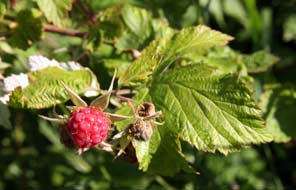 as if
a storm was approaching from the High Coast which we could just make out in the
misty distance down the coast, and checking the forecast later, the weather
looked grim for the next few days. The stormy haze passed, but evening brought
an early, dewy dusk and by 10-30pm it was fully dark. as if
a storm was approaching from the High Coast which we could just make out in the
misty distance down the coast, and checking the forecast later, the weather
looked grim for the next few days. The stormy haze passed, but evening brought
an early, dewy dusk and by 10-30pm it was fully dark.
The following day began bright for our day in camp
and wild raspberries picked around the camp made a perfect breakfast (see right). For
our day in camp, we made full use of the campsite wi-fi signal for Skype calls
with family, and the washing machine to catch up with laundry. But the moment
the washing was hung out, the sky darkened and heavy sea mist descended, the
heavy clammy air making drying washing impossible. A new edition of the web site
was finally completed and uploaded and a start made on the next one. Later in
the afternoon, local people gathered for a service at the Solbacken wooden
church down at the far corner of the campsite. Solbacken had proved a welcoming
haven of peacefulness; it is the only campsite we have ever used with its own church.
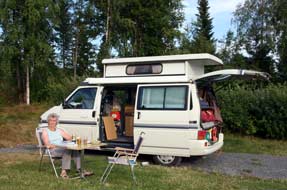 Örnsköldsvik, gateway to the High coast:
approaching Örnsköldsvik from the Dekarsön lane, it was clear that the town was
larger than expected with major industry and a large pulp and paper mill on the
far side of the bay. We found street parking close to the centre and the TIC in
the town library helpfully provided free maps for walks in the High Coast
National Park and good advice on routes. Traffic on the E4 which passes through
the town was intensely busy, the worst driving standards yet experienced in
Sweden, as we set off south from Örnsköldsvik in heavily overcast weather. The
terrain became wilder with rolling, forested hills but we could see little of it
in the gloomy clinging mist, and the aggressive traffic demanded full attention. We
passed the turning at Bjästa for the northern start-point for the High Coast
(Höga Kusten) walks and began the long haul where the E4 crosses the shoulder of the High
Coast's hilly land. It would have been spectacular countryside had we been able
to see it! The came the startlingly long descent of the southern side of the
hills with traffic building up behind slow-moving trucks. Even if the weather
had been clear, this volume of impatiently aggressive traffic on the steep,
lengthy hill made this feel a particularly hazardous stretch of road. At the
foot of the hill approaching Docksta, we were glad to pull into the High Coast
National Park Naturum which was overshadowed by the hill of Skuleberget. There
was however little impression of the hill's height with the totally enshrouding
misty cloud. We reached the Centre just in time for the English-language
presentation on the geomorphological background to the High Coast's unique
formation by the process of post-glacial isostatic land uplift. Örnsköldsvik, gateway to the High coast:
approaching Örnsköldsvik from the Dekarsön lane, it was clear that the town was
larger than expected with major industry and a large pulp and paper mill on the
far side of the bay. We found street parking close to the centre and the TIC in
the town library helpfully provided free maps for walks in the High Coast
National Park and good advice on routes. Traffic on the E4 which passes through
the town was intensely busy, the worst driving standards yet experienced in
Sweden, as we set off south from Örnsköldsvik in heavily overcast weather. The
terrain became wilder with rolling, forested hills but we could see little of it
in the gloomy clinging mist, and the aggressive traffic demanded full attention. We
passed the turning at Bjästa for the northern start-point for the High Coast
(Höga Kusten) walks and began the long haul where the E4 crosses the shoulder of the High
Coast's hilly land. It would have been spectacular countryside had we been able
to see it! The came the startlingly long descent of the southern side of the
hills with traffic building up behind slow-moving trucks. Even if the weather
had been clear, this volume of impatiently aggressive traffic on the steep,
lengthy hill made this feel a particularly hazardous stretch of road. At the
foot of the hill approaching Docksta, we were glad to pull into the High Coast
National Park Naturum which was overshadowed by the hill of Skuleberget. There
was however little impression of the hill's height with the totally enshrouding
misty cloud. We reached the Centre just in time for the English-language
presentation on the geomorphological background to the High Coast's unique
formation by the process of post-glacial isostatic land uplift.
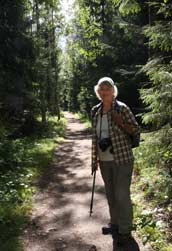 The High coast's formation by post-glacial land
uplift: During the last Ice Age (Weichsel), the ice-sheet covering
Northern Europe reached its maximum depth of 3kms around 20,000 years ago. The
massive weight of this 3km deep ice-sheet depressed the earth's outer crust by
up to 1000m around the area of the High Coast. As the earth's climate warmed
around 10,000 years ago, the Ice Age glacial sheet retreated towards the
interior of Northern Sweden as the ice melted. Relieved of the weight and
pressure of the ice-sheet, the land began to rise again, relatively quickly at
first at a rate of 10cms a year (10m every 100 years), with the rate of uplift
fastest where the depression of the land had been greatest around the High
Coast. When the margin of the ice-sheet had retreated NW of the High Coast
around 9,600 year ago, the area had already risen almost 500m from its lowest
level of depression; since then the land has risen an additional 300m for a
total of 800m from its lowest to current levels. The land is still rising but at
a slower rate of 8mm/year (1m/century) and assuming no other global changes
intervene (eg a further Ice Age or sea level changes due to polar ice melting),
it will take a further 10,000 years for the earth's crust to re-assert its
pre-glacial level. As a result of this final phase of post-glacial isostatic
uplift, the Bothnian Gulf at its northern end will have become so shallow that
by then Sweden and Finland will be joined by a land-bridge. The High coast's formation by post-glacial land
uplift: During the last Ice Age (Weichsel), the ice-sheet covering
Northern Europe reached its maximum depth of 3kms around 20,000 years ago. The
massive weight of this 3km deep ice-sheet depressed the earth's outer crust by
up to 1000m around the area of the High Coast. As the earth's climate warmed
around 10,000 years ago, the Ice Age glacial sheet retreated towards the
interior of Northern Sweden as the ice melted. Relieved of the weight and
pressure of the ice-sheet, the land began to rise again, relatively quickly at
first at a rate of 10cms a year (10m every 100 years), with the rate of uplift
fastest where the depression of the land had been greatest around the High
Coast. When the margin of the ice-sheet had retreated NW of the High Coast
around 9,600 year ago, the area had already risen almost 500m from its lowest
level of depression; since then the land has risen an additional 300m for a
total of 800m from its lowest to current levels. The land is still rising but at
a slower rate of 8mm/year (1m/century) and assuming no other global changes
intervene (eg a further Ice Age or sea level changes due to polar ice melting),
it will take a further 10,000 years for the earth's crust to re-assert its
pre-glacial level. As a result of this final phase of post-glacial isostatic
uplift, the Bothnian Gulf at its northern end will have become so shallow that
by then Sweden and Finland will be joined by a land-bridge.
The High Coast area, which had always been
mountainous due to pre-glacial ancient volcanic formation of high land, has now
re-asserted its lofty height and shows other evidential features of ice-retreat
and land-uplift. Such features include hill-tops capped with moraine-till more
fertile than the underlying bed-rock and therefore topped with a covering of
spruce above the bare rock slopes which mark the Ice-Age shoreline, and former
bays of the sea now trapped inland by the land-uplift to form lakes in which
former sea-living fauna have evolved to adapt to freshwater conditions. Because
of the unique evidence which the High Coast area shows of this geomorphological
process of post-glacial isostatic land uplift, the region has been accorded
UNESCO World Heritage status.
A dismally wet weather camp at Docksta: the
Naturum staff had given us a clearer understanding of why the High Coast area is
so special and we sought further advice from them on walks in the High Coast National Park;
all we need now was some fine weather to enjoy this remarkable natural
environment. Re-joining the furious traffic on E4 for 4kms, we turned off into Docksta Vandrahem och Camping where the camping area sloped steeply up the
hillside overlooking the busy highway. We received a pleasant welcome from
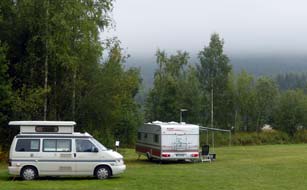 the
young staff at the restaurant which served as campsite reception, and were
pleasantly surprised at the reasonable price of 200kr/night all in including
wi-fi. But there was no avoiding the slope to find a flattish pitch and no
escaping the ever-present traffic noise, and the low mist down to tree-top
levels gave a depressingly gloomy air. The low mist clung on the following
morning and with rain threatening, this was no weather for walking in the High
Coast; another day in camp was the best use of time and we battened down for a
day of writing and researching options for boat rides out to the off-shore
islands. The mist got wetter finally turning to rain, wetter than at any other
point of the trip. We seemed enveloped in wet, misty cloud making everything
feel damp, but a late afternoon weather check forecast a more optimistic change
to sunnier conditions tomorrow. But with this wet, gloomy cloud stuck over us
with stagnant air and no wind to shift it, this seemed hard to believe; with rain
still pouring and the heater on full, we were thankful to be snug, dry and
comfortably warm inside George (see left). We had been carefully managing our
limited supplies of Camping Gaz by using campsite kitchens wherever possible.
But tonight, as we cooked a warming supper of meatballs in lingonberry sauce in
pouring rain, Sod's Law dictated that this was just the weather for our
first gas cylinder to run out; it did of course, meaning a wet change of gas
bottle! the
young staff at the restaurant which served as campsite reception, and were
pleasantly surprised at the reasonable price of 200kr/night all in including
wi-fi. But there was no avoiding the slope to find a flattish pitch and no
escaping the ever-present traffic noise, and the low mist down to tree-top
levels gave a depressingly gloomy air. The low mist clung on the following
morning and with rain threatening, this was no weather for walking in the High
Coast; another day in camp was the best use of time and we battened down for a
day of writing and researching options for boat rides out to the off-shore
islands. The mist got wetter finally turning to rain, wetter than at any other
point of the trip. We seemed enveloped in wet, misty cloud making everything
feel damp, but a late afternoon weather check forecast a more optimistic change
to sunnier conditions tomorrow. But with this wet, gloomy cloud stuck over us
with stagnant air and no wind to shift it, this seemed hard to believe; with rain
still pouring and the heater on full, we were thankful to be snug, dry and
comfortably warm inside George (see left). We had been carefully managing our
limited supplies of Camping Gaz by using campsite kitchens wherever possible.
But tonight, as we cooked a warming supper of meatballs in lingonberry sauce in
pouring rain, Sod's Law dictated that this was just the weather for our
first gas cylinder to run out; it did of course, meaning a wet change of gas
bottle!
A day's walking in the High Coast National
Park: after the darkest night so far when it seemed impossible to
believe a change in the weather, the wind unbelievably got up during the night
and we woke to breaks in the cloud and even hints of blue sky and sun. There was
hope for a fine day and the forecast still insisted on clear sun. It was only the
last day of July but this morning there was a distinct feel of early autumn and
the first sign of birches leaves turning yellow. Despite yesterday's intense rain
(there were 2 inches of rainwater in the bowls), the ground showed no sign of
being waterlogged; it sloped so much that all the water drained downhill to the
E4! Leaving Docksta Camping, we returned back up the long drag over the shoulder
of Skuleskogens, to turn off at Bjästa along the lane towards the coast and the
northern entrance to the Höga Kusten (High Coast)/Skuleskogens
National Park. Reaching the car park at the end of the lane, we booted up,
taking full waterproofs despite the by now fine weather, and set off along the
way-marked path through the pine woods down to the enclosed bay of Salsviken.
The path went forward along the coast where waves washed onto the forested
shore-line, reaching a junction where a signpost pointed upwards to Slåttdalsskrevan, the high and narrow gorge at the watershed of Slåttdalsberget,
our goal for today and a 9km there and back walk.
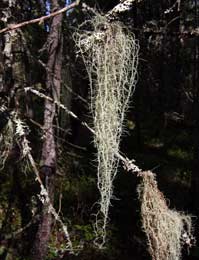 The
path to Slåttdalsskrevan Gorge: the serious height gain now began, a
gruellingly unremitting slog up through the pines on a steep path poor underfoot
with tree-roots and boulders, and under dense forest cover wet from yesterday's
rain. The only distractions from the tedium of this upwards haul were the clumps
of light grey-green Beard-lichen (Usnea longissima) hanging on the pine
branches (see right). This rare species of epiphytic lichen, associated with ancient forests
with high, The
path to Slåttdalsskrevan Gorge: the serious height gain now began, a
gruellingly unremitting slog up through the pines on a steep path poor underfoot
with tree-roots and boulders, and under dense forest cover wet from yesterday's
rain. The only distractions from the tedium of this upwards haul were the clumps
of light grey-green Beard-lichen (Usnea longissima) hanging on the pine
branches (see right). This rare species of epiphytic lichen, associated with ancient forests
with high,
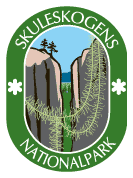 even humidity, features on the Höga Kusten/Skuleskogens
National Park emblem along with the Slåttdalsskrevan Gorge (see left). The
other attraction was picking the ripe, juicy bilberries that carpeted the forest
floor when we paused frequently for breath. The path flattened along a shelf
above the rapidly flowing Skravelbäcken torrent cascading down the hill-slope,
and crossed on a wooden footbridge to climb steeply up the wet, rocky far bank
and continue ahead, shelving round through the pines to gain further height
(Photo 16 - Walking in High Coast National Park).
This next section of path was even more impeded by tangled tree roots and
rounded bounded boulders, the remains of ancient beaches pre-dating the
land-uplift; however interesting geologically, the ever-rising path through the
dark and featureless pine woods needed constant attention to avoid slipping on
the wet boulders or twisting an ankle on the snaring tree roots. Eventually we
reached the smaller of the 2 Tärnättvattnen lakes, once a bay of the sea when
the ice first melted and before the land rose to isolate them. Passing the lake
with the sun sparkling on the water and a distant first glimpse of the Slåttdalsskrevan
Gorge on the skyline, bright red clumps of dwarf cornel berries grew among the
boulders along the lake shore. Board-walks led across the intervening 200m of
marshy ground to reach the larger lake, and here at the meeting of paths a number
of walkers gathered. There was now a clearer view of the still distant gorge,
but we still had much height to gain. even humidity, features on the Höga Kusten/Skuleskogens
National Park emblem along with the Slåttdalsskrevan Gorge (see left). The
other attraction was picking the ripe, juicy bilberries that carpeted the forest
floor when we paused frequently for breath. The path flattened along a shelf
above the rapidly flowing Skravelbäcken torrent cascading down the hill-slope,
and crossed on a wooden footbridge to climb steeply up the wet, rocky far bank
and continue ahead, shelving round through the pines to gain further height
(Photo 16 - Walking in High Coast National Park).
This next section of path was even more impeded by tangled tree roots and
rounded bounded boulders, the remains of ancient beaches pre-dating the
land-uplift; however interesting geologically, the ever-rising path through the
dark and featureless pine woods needed constant attention to avoid slipping on
the wet boulders or twisting an ankle on the snaring tree roots. Eventually we
reached the smaller of the 2 Tärnättvattnen lakes, once a bay of the sea when
the ice first melted and before the land rose to isolate them. Passing the lake
with the sun sparkling on the water and a distant first glimpse of the Slåttdalsskrevan
Gorge on the skyline, bright red clumps of dwarf cornel berries grew among the
boulders along the lake shore. Board-walks led across the intervening 200m of
marshy ground to reach the larger lake, and here at the meeting of paths a number
of walkers gathered. There was now a clearer view of the still distant gorge,
but we still had much height to gain.
The path led on through woods and across
steep bed-rock, the granite now giving good footing, to reach a high rocky
plateau with a magnificent panorama above the lower forest and lake out to the
distant sea and islands on the horizon
(Photo 17 - View out to the distant Baltic islands). More crippling height gain, and suddenly
we became aware of the walls of gorge closing in around us; we had reached the
100m long, 7m wide gorge of Slåttdalsskrevan enclosed by dark, dank sheer-sided
walls 30m high, once a 7m wide vein of dolerite which over aeons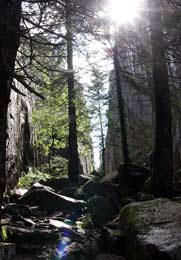 had been eroded
away leaving the gorge between high walls of the harder, more resistant granite.
We stood there in awe looking up this dark groove with the sun shining down the
gorge from its head at the southern end (Photo 18 - View from foot of Slåttdalsskrevan Gorge). Water dripped from the dank side-wall
that was in permanent shade while sunlight lit the opposite face (see left). The bed of the
gorge, which sloped upwards at a steep angle, was littered with red granite had been eroded
away leaving the gorge between high walls of the harder, more resistant granite.
We stood there in awe looking up this dark groove with the sun shining down the
gorge from its head at the southern end (Photo 18 - View from foot of Slåttdalsskrevan Gorge). Water dripped from the dank side-wall
that was in permanent shade while sunlight lit the opposite face (see left). The bed of the
gorge, which sloped upwards at a steep angle, was littered with red granite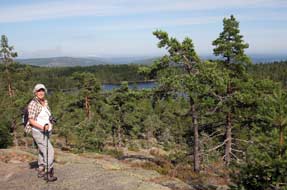 boulders made treacherously slippery by water running down the enclosed slope.
Gingerly we made our way upwards, and at the top a steep wooden step-ladder led
to the very lip of the gorge where we emerged onto the narrow watershed where
the High Coast path descended even more steeply on the southern side. A number
of other walkers were also gathered here making the narrow, confined col a very
crowded little spot. The view looking back down into the gorge from the
watershed emphasised the
impressive height of its sheer, vertical red granite enclosing walls, but the
harsh contrast of light and shade made it difficult to achieve a photograph
which did justice to this stunning setting (Photo 19 - Looking down Slåttdalsskrevan Gorge from watershed). We signed the visitor book and
geared up for the descent, dropping back down the ladder to negotiate the steep
and treacherously slippery slabs and boulders down the 100m length of the gorge,
back into the trees at the bottom. After a snack pause on the rocky plateau
looking out to the distant sea beyond the Höga Kusten forests and lakes (see
right), we
began the long and wearying return walk down through the pine forests.
boulders made treacherously slippery by water running down the enclosed slope.
Gingerly we made our way upwards, and at the top a steep wooden step-ladder led
to the very lip of the gorge where we emerged onto the narrow watershed where
the High Coast path descended even more steeply on the southern side. A number
of other walkers were also gathered here making the narrow, confined col a very
crowded little spot. The view looking back down into the gorge from the
watershed emphasised the
impressive height of its sheer, vertical red granite enclosing walls, but the
harsh contrast of light and shade made it difficult to achieve a photograph
which did justice to this stunning setting (Photo 19 - Looking down Slåttdalsskrevan Gorge from watershed). We signed the visitor book and
geared up for the descent, dropping back down the ladder to negotiate the steep
and treacherously slippery slabs and boulders down the 100m length of the gorge,
back into the trees at the bottom. After a snack pause on the rocky plateau
looking out to the distant sea beyond the Höga Kusten forests and lakes (see
right), we
began the long and wearying return walk down through the pine forests.
A night at Överhörnäs Camping: we now
had to find a campsite for tonight close by, ready for tomorrow's planned boat
trip out to Trysunda island. The Swedish Camping Association book listed a site
at Överhörnäs ideally placed just off the E4 9kms south of Örnsköldsvik and only
15 minutes drive from Köpmanholmen from where the boats crossed to the off-shore
islands. Having shopped for provisions at the surprisingly large ICA supermarket
in Bjästa, we drove back north to turn off the E4 and were welcomed at
Överhörnäs Camping. The small campsite at a good value 200 kr/night was spread
along a lake shore looking out across the valley towards Själerad church; even
in the busy holiday season, it was a very pleasant and welcoming site.
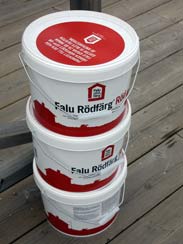 The off-shore High Coast island of Trysunda:
returning to the little harbour Köpmanholmen, we found the car park almost full,
either day-visitors on the 9-00am boat to the larger island of Ulvön or seasonal
summer residents on the islands. We had arrived early to ensure seats on the
boat over to Trysunda but the jetty was almost deserted. While waiting for
the M/S Minerva, we got into conversation with a charming Swedish couple
who lived in Kalix near The off-shore High Coast island of Trysunda:
returning to the little harbour Köpmanholmen, we found the car park almost full,
either day-visitors on the 9-00am boat to the larger island of Ulvön or seasonal
summer residents on the islands. We had arrived early to ensure seats on the
boat over to Trysunda but the jetty was almost deserted. While waiting for
the M/S Minerva, we got into conversation with a charming Swedish couple
who lived in Kalix near
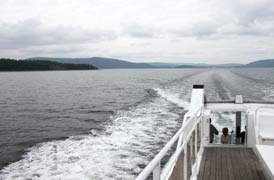 Haparanda in the Finnish borderlands during the winter
but had a summer cottage on Ulvön to where they were now returning laden with
shopping and 10 litre drums of Falu Rödfärg preservative for painting their
cottage's woodwork. We remarked on this saying we had seen the Rödfärg factory
while visiting the copper mines at Falun earlier in our trip (see our log);
like everything else, you could buy cheaper wood preservative, but the real
McCoy
with royal seal of approval cost a whopping 500kr for a 10 litre drum and
south-facing walls needed repainting every 5 years. Their English was faultless
and we learnt much from them about Swedish life and they recommended we try the
local island 'delicacy' of Surströmming, fermented herring made on Ulvön since
the 16th century when salt was scarce. They did however warn us only to open the
tin outside since the foul-smelling rotten fish stank something dreadful like an
open sewer! Despite this, and the fact that most southern Swedes turn up their
noses (literally!) at the stuff, we should at least give it a try with potato,
onion, tomato, and tunn-bröd. On a more savoury note, they also recommended Kalles-kaviar
sold in tubes which we had seen in supermarkets, and warmed cloudberry jam
served with
ice cream. We learned much from this couple, and helped them aboard the ferry
boat with the drums of Falu Rödfärg, sitting with them on the 25 minute crossing
as they pointed out the islands of the archipelago. Just after leaving Köpmanholmen,
the boat passed along the High Coast cliffs below the hills where we had walked
yesterday (Photo 20 - Crossing to Trysunda from Köpmanholmen). Haparanda in the Finnish borderlands during the winter
but had a summer cottage on Ulvön to where they were now returning laden with
shopping and 10 litre drums of Falu Rödfärg preservative for painting their
cottage's woodwork. We remarked on this saying we had seen the Rödfärg factory
while visiting the copper mines at Falun earlier in our trip (see our log);
like everything else, you could buy cheaper wood preservative, but the real
McCoy
with royal seal of approval cost a whopping 500kr for a 10 litre drum and
south-facing walls needed repainting every 5 years. Their English was faultless
and we learnt much from them about Swedish life and they recommended we try the
local island 'delicacy' of Surströmming, fermented herring made on Ulvön since
the 16th century when salt was scarce. They did however warn us only to open the
tin outside since the foul-smelling rotten fish stank something dreadful like an
open sewer! Despite this, and the fact that most southern Swedes turn up their
noses (literally!) at the stuff, we should at least give it a try with potato,
onion, tomato, and tunn-bröd. On a more savoury note, they also recommended Kalles-kaviar
sold in tubes which we had seen in supermarkets, and warmed cloudberry jam
served with
ice cream. We learned much from this couple, and helped them aboard the ferry
boat with the drums of Falu Rödfärg, sitting with them on the 25 minute crossing
as they pointed out the islands of the archipelago. Just after leaving Köpmanholmen,
the boat passed along the High Coast cliffs below the hills where we had walked
yesterday (Photo 20 - Crossing to Trysunda from Köpmanholmen).
A walk around Trysunda island: M/S Minerva was soon approaching the
tiny harbour of Trysunda, which was originally 3 islets separated by 3 straits (hence
the name Try-sunda meaning 3 sounds). But the land-rise caused 2 of the
channels to silt up merging the 3 former islets into the one larger tricorne
shaped lager island seen today. The one remaining sound leads into the narrow
well-protected fishing harbour of Trysunda, its sides lined by red-painted
wooden cottages and fishing sheds. Waving farewell to the couple who had invited
us for coffee if we were ever on Ulvön
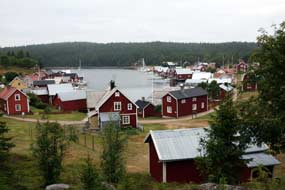 ("Just ask for us by name" they said,
"Anyone will know where we live"), we clambered ashore on the tiny jetty as the
ferry pulled away to continue on to Ulvön. From the jetty, we set off along the
footpath behind the harbour-front cottages around the head of the narrow inlet
looking out across to the tiny fishing village with its red-painted houses. A
rocky outcrop ("Just ask for us by name" they said,
"Anyone will know where we live"), we clambered ashore on the tiny jetty as the
ferry pulled away to continue on to Ulvön. From the jetty, we set off along the
footpath behind the harbour-front cottages around the head of the narrow inlet
looking out across to the tiny fishing village with its red-painted houses. A
rocky outcrop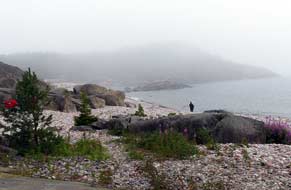 with a look-out atop looked down over the inlet harbour (see left); from this
paradise garden of creeping bearberry with residual bell-shaped flowers and
ripening berries carpeting the rocks, and crowberry with shiny black fruits, the
view down the length of Trysunda's remaining inlet would have been splendid but
for the sea mist now making the little harbour gloomy (Photo 21 - Trysunda village and harbour in misty weather). A path led through woods
along what once would have been Trysunda's second sound over to the cobbled
boulder field of Storviken beach, but the mist was down to sea level making it
difficult to photograph the circuit of wave-polished boulders (see right). It was an eerily
beautiful spot in the gloomy sea mist as we sat on the rocks to eat our
sandwiches looking across the bay. From the boulder beach, a further path turned
steeply up into a narrow valley which would once have been the first of the
former sounds to disappear with the land-uplift. Now carpeted with lichen and
bilberry, the path zigzagged over to Björnviken with its beautiful wild beach of
fine white sand (Photo 22 - Sea mist over Björnviken white sand beach), the dunes behind the beach covered with marram grass and
sweetly scented wild roses (Photo 23 - Wild Roses growing by Björnviken beach).
Again the sea mist prevented this wild setting being seen at its glorious best.
with a look-out atop looked down over the inlet harbour (see left); from this
paradise garden of creeping bearberry with residual bell-shaped flowers and
ripening berries carpeting the rocks, and crowberry with shiny black fruits, the
view down the length of Trysunda's remaining inlet would have been splendid but
for the sea mist now making the little harbour gloomy (Photo 21 - Trysunda village and harbour in misty weather). A path led through woods
along what once would have been Trysunda's second sound over to the cobbled
boulder field of Storviken beach, but the mist was down to sea level making it
difficult to photograph the circuit of wave-polished boulders (see right). It was an eerily
beautiful spot in the gloomy sea mist as we sat on the rocks to eat our
sandwiches looking across the bay. From the boulder beach, a further path turned
steeply up into a narrow valley which would once have been the first of the
former sounds to disappear with the land-uplift. Now carpeted with lichen and
bilberry, the path zigzagged over to Björnviken with its beautiful wild beach of
fine white sand (Photo 22 - Sea mist over Björnviken white sand beach), the dunes behind the beach covered with marram grass and
sweetly scented wild roses (Photo 23 - Wild Roses growing by Björnviken beach).
Again the sea mist prevented this wild setting being seen at its glorious best.
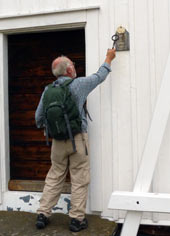 The path continued northwards under the island's
central knoll of Kapellsberget around to Rödskatevik, a more open beach lined
with red granite rocks and of course gritty red sand, and by now the mist was
beginning to lift and a weak sun shining through. We continued back through the
woods past the village graveyard around to the tiny wooden chapel built in 1654
by the island's first residents, fishermen from Gävle who used it during the
winter months to store their nets. Although the chapel The path continued northwards under the island's
central knoll of Kapellsberget around to Rödskatevik, a more open beach lined
with red granite rocks and of course gritty red sand, and by now the mist was
beginning to lift and a weak sun shining through. We continued back through the
woods past the village graveyard around to the tiny wooden chapel built in 1654
by the island's first residents, fishermen from Gävle who used it during the
winter months to store their nets. Although the chapel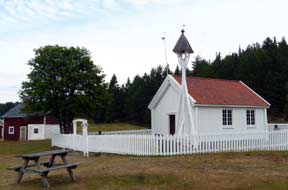 was locked, a large key
hung conveniently on a hook by the door (see left); inside the walls were covered with straightforward
rustic paintings including St George skewering a large dragon up on the west end
gable (Photo 24 - Trysunda's 17th century wooden church). The paintings had been made in 1711, the year in which King Karl XII
built a naval base at Trysunda; the artist was probably a craftsman on one of
the warships and like many of his fellow sailors came from Finland. After a walk
around the northern harbour-side and along the third former sound to another
small cove, we returned to Trysunda village stopping at one of the cottages
which advertised home-made Surströmming. The lady told us more about this local
specialty, again stressing the importance of storing the tin in the fridge to delay the
fermentation and opening it outdoors because of its foul stench; asked if she
like Surströmming, she replied "Certainly not, but no one has died of it yet!"
With grave reservations, we felt we should at least try it. Back around to the
jetty we waited for the boat self-consciously clutching our tin of Surströmming,
and with the sun now lighting the lovely red cottages around the narrow harbour
inlet we clambered aboard the M/S Ulvön (Photo 25 - Trysunda village and harbour). Passing the uninhabited islet of
Skrubban with its bird nesting cliffs, the boat made good progress back to Köpmanholmen. was locked, a large key
hung conveniently on a hook by the door (see left); inside the walls were covered with straightforward
rustic paintings including St George skewering a large dragon up on the west end
gable (Photo 24 - Trysunda's 17th century wooden church). The paintings had been made in 1711, the year in which King Karl XII
built a naval base at Trysunda; the artist was probably a craftsman on one of
the warships and like many of his fellow sailors came from Finland. After a walk
around the northern harbour-side and along the third former sound to another
small cove, we returned to Trysunda village stopping at one of the cottages
which advertised home-made Surströmming. The lady told us more about this local
specialty, again stressing the importance of storing the tin in the fridge to delay the
fermentation and opening it outdoors because of its foul stench; asked if she
like Surströmming, she replied "Certainly not, but no one has died of it yet!"
With grave reservations, we felt we should at least try it. Back around to the
jetty we waited for the boat self-consciously clutching our tin of Surströmming,
and with the sun now lighting the lovely red cottages around the narrow harbour
inlet we clambered aboard the M/S Ulvön (Photo 25 - Trysunda village and harbour). Passing the uninhabited islet of
Skrubban with its bird nesting cliffs, the boat made good progress back to Köpmanholmen.
Crossing the High Coast Bridge for a night at
Snibbens Camping: back ashore, we now had a 70km drive down the E4
through the High Coast region to reach tonight's campsite south of the
suspension bridge across the mouth of the wide Ångermanälven river. The
impressively elegant Höga-kustenbron (High Coast Bridge) built between 1993~97
with a total length of 1,800m and span of 1,210m between its pylons, is the
world's 14th longest suspension bridge (Denmark's Store Bælt
 Bridge is the 3rd
longest, UK's Humber Bridge the 7th longest, and San Francisco's Golden Gate
Bridge the 12th longest). Just beyond the bridge, we took a side turning for
3kms to Snibbens Camping, a lake-side campsite packed full of caravans. The
owners found us a space on a flat headland overlooking Lake Mörtsjön; in spite
of the inevitable noise, this was the best we could hope for in the peak holiday
season and later that evening we were treated to a glorious sunset across the
lake with the entire western sky lit by a golden ruddy glow (Photo 26 - Sunset over Lake Mörtsjön). The following
morning with a clear sun and sky reflected on the lake's blue waters, we
returned across the High Coast Bridge and pulled off at the northern end
into a parking area; here with ancient pines in the foreground was the finest
photographic angle down the length of this magnificent bridge (Photo 27 - Höga-kustenbron (High Coast Bridge) spanning Ångermanälven river). Bridge is the 3rd
longest, UK's Humber Bridge the 7th longest, and San Francisco's Golden Gate
Bridge the 12th longest). Just beyond the bridge, we took a side turning for
3kms to Snibbens Camping, a lake-side campsite packed full of caravans. The
owners found us a space on a flat headland overlooking Lake Mörtsjön; in spite
of the inevitable noise, this was the best we could hope for in the peak holiday
season and later that evening we were treated to a glorious sunset across the
lake with the entire western sky lit by a golden ruddy glow (Photo 26 - Sunset over Lake Mörtsjön). The following
morning with a clear sun and sky reflected on the lake's blue waters, we
returned across the High Coast Bridge and pulled off at the northern end
into a parking area; here with ancient pines in the foreground was the finest
photographic angle down the length of this magnificent bridge (Photo 27 - Höga-kustenbron (High Coast Bridge) spanning Ångermanälven river).
A visit to Härnösand: rejoining the
E4 and crossing the toll-free Höga-kustenbron for the third time, we continued
south through the rolling countryside of Ångermanland province. Reaching
Härnösand, we turned off for a brief look at this little town at the mouth of
the Ångerman River. Founded in 1647 by King Johan III, the town's church became
the cathedral of Sweden's then most northerly diocese. Härnösand suffered its
share of fires over the centuries and was razed by invading Russians in the 1721
Great Northern War. Parking on the mainland side of the bridge, we walked over
to the town centre set on a river island. For a small provincial town Härnösand's grandiose Storatorget was surrounded by noble buildings with the
neo-Classical former provincial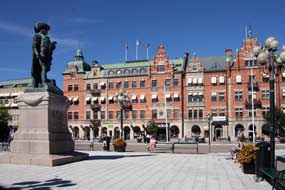 governor's residence lining its western side.
Armed with a town plan from the TIC, we walked around the centre to find the
1840 Domkyrkan, the country's smallest cathedral, and nearby the 18th century
wooden cottages of Östanbäcksgan, before resuming our journey south. governor's residence lining its western side.
Armed with a town plan from the TIC, we walked around the centre to find the
1840 Domkyrkan, the country's smallest cathedral, and nearby the 18th century
wooden cottages of Östanbäcksgan, before resuming our journey south.
A delightful afternoon at Sundsvall: crossing
into Medelpad province, and making good progress south on the E4 to approach the
provincial capital Sundsvall, first impressions were unsavoury with a succession
of vast commercial and industrial estates lining the highway. But guided by the
satnav, we pulled off into the central area of the town to park by the Kulturmagazinet, a cluster of 4 late 19th century stone-built warehouses now
impressively spanned by connecting glass roofs to form the town's library and
museum complex. Sundsvall developed in 1621 from the time of Gustav II Adolfus
as a
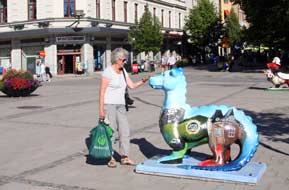 wealthy trading centre on the Bothnian coast particularly for timber export
from its port. But at midsummer 1888, the worst ever fire, started from a
wood-burning steam-boat, destroyed the entire town with 9,000 houses burnt down.
Such however was the town's wealth that within 10 years Sundsvall was rebuilt
constructed wholly from stone by Stockholm's leading architects with wide
streets and esplanades as fire breaks. The town centre today shows this turn of
20th century grandiose urban architecture giving Sundsvall the sobriquet of
Stenstaden (Stone City). To make way for the new city, its working classes
were moved from their old homes in the centre to cramped areas in the outskirts,
a stark contrast between affluence and impoverishment. wealthy trading centre on the Bothnian coast particularly for timber export
from its port. But at midsummer 1888, the worst ever fire, started from a
wood-burning steam-boat, destroyed the entire town with 9,000 houses burnt down.
Such however was the town's wealth that within 10 years Sundsvall was rebuilt
constructed wholly from stone by Stockholm's leading architects with wide
streets and esplanades as fire breaks. The town centre today shows this turn of
20th century grandiose urban architecture giving Sundsvall the sobriquet of
Stenstaden (Stone City). To make way for the new city, its working classes
were moved from their old homes in the centre to cramped areas in the outskirts,
a stark contrast between affluence and impoverishment.
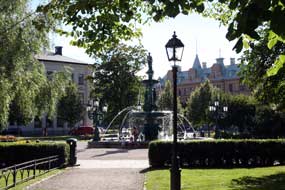 On a sunny afternoon, we walked along the wide
Esplanaden through to Stortorget photographing the grandiose buildings and
parklands (Photo 28 - Sundvall's delightful city centre). Scattered around the centre small colourful dragon statues stood at
street corners, each numbered with its sponsoring company's plaque their fiery
breath recalling the disastrous fire of 1888. Each summer a competition is held
to elect the most popular of these colourful dragon statues (see left). Sundsvall's Stortorget, the large, open main square is lined with grandiose buildings and in the centre a statue of Gustav II Adolfus gazes regally over the town he
founded (Photo 29 - Gustav II Adolfus's statue in Sundall's central square). At the TIC in the rådhus we picked up a town plan and voted in the
dragon competition for Häsbe and Erica the ICA dragon; though we shall never
know the 2013 result, it was all good fun. After a walk up Kyrkogatan past the
town's grand restoration buildings to see the late 19th century Gustav Adolfs
kyrkan, we returned through the centre viewing more of the dragons for a brief
visit to the Kulturmagazinet museum and admire the glazed-in structure of the
restored warehouses. The English language leaflet accompanying the City that
Changed exhibition told the story of Sundall's prosperity as a trading
centre and the town's post-1888 great fire stone restoration. This had been a
thoroughly enjoyable afternoon ambling around this delightful city in the
sunshine, but we now had a long drive ahead to reach tonight's campsite near to
Hudiksvall On a sunny afternoon, we walked along the wide
Esplanaden through to Stortorget photographing the grandiose buildings and
parklands (Photo 28 - Sundvall's delightful city centre). Scattered around the centre small colourful dragon statues stood at
street corners, each numbered with its sponsoring company's plaque their fiery
breath recalling the disastrous fire of 1888. Each summer a competition is held
to elect the most popular of these colourful dragon statues (see left). Sundsvall's Stortorget, the large, open main square is lined with grandiose buildings and in the centre a statue of Gustav II Adolfus gazes regally over the town he
founded (Photo 29 - Gustav II Adolfus's statue in Sundall's central square). At the TIC in the rådhus we picked up a town plan and voted in the
dragon competition for Häsbe and Erica the ICA dragon; though we shall never
know the 2013 result, it was all good fun. After a walk up Kyrkogatan past the
town's grand restoration buildings to see the late 19th century Gustav Adolfs
kyrkan, we returned through the centre viewing more of the dragons for a brief
visit to the Kulturmagazinet museum and admire the glazed-in structure of the
restored warehouses. The English language leaflet accompanying the City that
Changed exhibition told the story of Sundall's prosperity as a trading
centre and the town's post-1888 great fire stone restoration. This had been a
thoroughly enjoyable afternoon ambling around this delightful city in the
sunshine, but we now had a long drive ahead to reach tonight's campsite near to
Hudiksvall
A ghastly campsite at the Hornslandet
peninsula: passing the aluminium smelter and other heavy industry on
Sundvall's southern outskirts, we set off for the 60km drive down towards
Hudiksvall where we had 2 possible campsite options out on the Hornslandet
peninsula. Turning off the E4 highway, we followed minor roads around to
Malnbadens Camping. Initial impressions
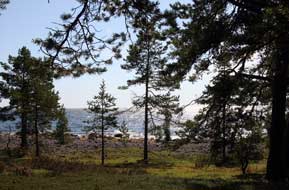 suggested an overcrowded campsite, and
we phoned the alternative Hölick Havsresort; the very name should have alerted
us to this major error. But it was close to the Hornslandet peninsula nature
reserve where we wanted to walk, they could supply us with maps and walking
route details, and supposedly had spaces, and we set off across the peninsula.
Only on our arrival did we discover our misjudgement: here among the pine woods
was a sordidly overcrowded bedlam, with every square centimetre crammed full of
caravans, mind-numbing noise levels, and charging 270kr/night for the privilege
of staying in this hell-hole. Doggedly weary after an otherwise enjoyable day
and with no option but to grin and bear it tonight, we settled in and resorted
to nature's panacea for all woes, a cold beer, but even this failed us in these
desperate circumstances! Doubtless in May or October the pine woods surroundings
of this place would be deserted; but in the summer holiday period this was an
absolute NO-NO to be avoided at all costs! suggested an overcrowded campsite, and
we phoned the alternative Hölick Havsresort; the very name should have alerted
us to this major error. But it was close to the Hornslandet peninsula nature
reserve where we wanted to walk, they could supply us with maps and walking
route details, and supposedly had spaces, and we set off across the peninsula.
Only on our arrival did we discover our misjudgement: here among the pine woods
was a sordidly overcrowded bedlam, with every square centimetre crammed full of
caravans, mind-numbing noise levels, and charging 270kr/night for the privilege
of staying in this hell-hole. Doggedly weary after an otherwise enjoyable day
and with no option but to grin and bear it tonight, we settled in and resorted
to nature's panacea for all woes, a cold beer, but even this failed us in these
desperate circumstances! Doubtless in May or October the pine woods surroundings
of this place would be deserted; but in the summer holiday period this was an
absolute NO-NO to be avoided at all costs!
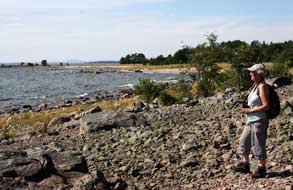 The Hornslandet peninsula nature reserve and
Hölick fishing village: after a grim, sleepless night of screaming
dogs, yapping kids, raucous holiday-makers and blaring TVs, we took stock: we
should leave the holiday hoards to their beaches, enjoy a day's walking in the
peaceful Hornslandet peninsula, then move back to the comparatively civilised
Malnbadens Camping tonight before visiting Hudiksvall tomorrow and moving on to Gävle. Never had we been so glad to be packing up; our spirits rose as we drove
away and parked around the corner ready for today's walk around the Hornslandet
peninsula nature reserve. The path we planned to follow was well-marked and
began as a forest trail through pine woods, continuing alongside beautifully
peaceful pine-fringed pebble beaches with the blue sea sparkling in the morning
sunshine. The forest edge was densely carpeted with bearberry, its luxuriant
growth creeping down into the sandy shore. Tiny patches of ripening red
lingonberry and scented tufts of ling grew among the bearberries under the
pines. Higher up across the pebbly beach, there were more classic examples of
tiered raised beach boulder fields. Revelling in the peacefulness of this
pine-fringed coastline, we paused for our sandwich lunch sat among the pebbles
looking out to the sparkling sea (Photo 30 - Lunch on a raised beach at Hornslandet peninsula). The marked path turned inland up across the
raised beach boulder fields into the pine forest to reach a junction from where
a path with good surface of sand and pine needles sloped downwards to our start
point amid the peacefulness of glorious woodland flora. The Hornslandet peninsula nature reserve and
Hölick fishing village: after a grim, sleepless night of screaming
dogs, yapping kids, raucous holiday-makers and blaring TVs, we took stock: we
should leave the holiday hoards to their beaches, enjoy a day's walking in the
peaceful Hornslandet peninsula, then move back to the comparatively civilised
Malnbadens Camping tonight before visiting Hudiksvall tomorrow and moving on to Gävle. Never had we been so glad to be packing up; our spirits rose as we drove
away and parked around the corner ready for today's walk around the Hornslandet
peninsula nature reserve. The path we planned to follow was well-marked and
began as a forest trail through pine woods, continuing alongside beautifully
peaceful pine-fringed pebble beaches with the blue sea sparkling in the morning
sunshine. The forest edge was densely carpeted with bearberry, its luxuriant
growth creeping down into the sandy shore. Tiny patches of ripening red
lingonberry and scented tufts of ling grew among the bearberries under the
pines. Higher up across the pebbly beach, there were more classic examples of
tiered raised beach boulder fields. Revelling in the peacefulness of this
pine-fringed coastline, we paused for our sandwich lunch sat among the pebbles
looking out to the sparkling sea (Photo 30 - Lunch on a raised beach at Hornslandet peninsula). The marked path turned inland up across the
raised beach boulder fields into the pine forest to reach a junction from where
a path with good surface of sand and pine needles sloped downwards to our start
point amid the peacefulness of glorious woodland flora.
The fishing hamlet of Kuggörarna: down to the lane's end at the near-deserted tiny
fishing hamlet of Hölick, wooden fishing sheds and boat houses lined the little
quay (Photo 31 - Fishing sheds at Hölick harbour), and wild raspberries lined the lane through the village along to the
pilot-station. Before leaving Hornslandet, we drove across the width of the
peninsula to the east coast where a bridge led across a narrow sound to the tiny
island of Kuggörarna. The lane ended at a car park from where a 500m footpath
led to the fishing hamlet of red-painted cottages clustered around the sheltered
islet. We walked around this truly beautiful setting, where above the cottages
on the stark, pebbly raised beach rows of tiny wooden shack-privies stood in
lines
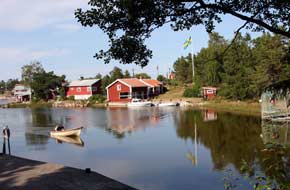 and fishing nets were strung out on drying frames. The small 18th century
wooden chapel stood in splendid isolation up on the pebbly hillock overlooking
the open sea and and fishing nets were strung out on drying frames. The small 18th century
wooden chapel stood in splendid isolation up on the pebbly hillock overlooking
the open sea and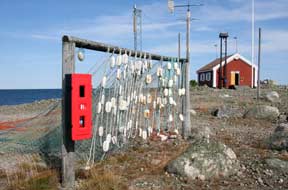 approached by a board-walk across the pebbles (Photo 32 - Wooden chapel and drying fishing nets at Kuggörarna). Again a large
key hung on a nail on the chapel wall, and inside the wooden walls were
elegantly simple and undecorated. The peacefulness of this place was palpable.
Beyond the cottages, with signs advertising smoked fish, the headland was capped
with a circular labyrinth marked on the ground by stones (Photo 33 - Medieval stone labyrinth on headland at Kuggörarna); thought to date from
medieval times, no one really knows the significance of such mazes, perhaps some
sort of fishermen's luck superstition for fair weather and good catch.
Reluctantly leaving the seclusion of Kuggörarna, we returned across the
peninsula to Malnbadens Camping; however crowded, it had to be better than last
night's dreadful experience! At reception we were received affably, and although
still expensive at 250kr/night, there was plenty of space with large pitches
terraced up the slope and shaded with pines. approached by a board-walk across the pebbles (Photo 32 - Wooden chapel and drying fishing nets at Kuggörarna). Again a large
key hung on a nail on the chapel wall, and inside the wooden walls were
elegantly simple and undecorated. The peacefulness of this place was palpable.
Beyond the cottages, with signs advertising smoked fish, the headland was capped
with a circular labyrinth marked on the ground by stones (Photo 33 - Medieval stone labyrinth on headland at Kuggörarna); thought to date from
medieval times, no one really knows the significance of such mazes, perhaps some
sort of fishermen's luck superstition for fair weather and good catch.
Reluctantly leaving the seclusion of Kuggörarna, we returned across the
peninsula to Malnbadens Camping; however crowded, it had to be better than last
night's dreadful experience! At reception we were received affably, and although
still expensive at 250kr/night, there was plenty of space with large pitches
terraced up the slope and shaded with pines.
A memorable visit to Happy Hudiksvall:
on a warm, sunny Sunday morning, we drove into Hudiksvall and parked without
difficulty in the quiet centre. Hudiksvall was granted its town status in 1582
by King Johan III making it Norrland's second oldest foundation after Gävle. It
became a prosperous timber trading and fishing port, originally built around the
bay of Lillfjärden at the mouth of the River Hornån until the harbour silted up
when the town and port moved closer to the coast in the 1640s. The former bay is
now a lake just inland connected to the sea by a narrow canal through the town
centre. The town has suffered a series of disastrous fires during its history
and was razed to the ground during the 1721 Great Northern War when Peter the Great's Russian army bombarded the town, burning and looting every building
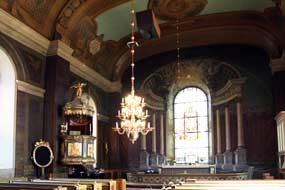 except the church which still bears the cannon marks. Despite this chequered
history, such was Hudiksvall's mercantile prosperity that it gained the nickname
Glada Hudik (Happy Hudiksvall). We walked through the peacefully floral
Stortorget past the Hasingland Museum, unfortunately closed on Sundays, and
along the shady little canal to its exit from the Lillfjärden lake which now
forms an attractive backdrop to the town. Up the hill we found the white stone,
onion-domed St Jakobs kyrka where the Sunday morning service was just ending and
the congregation drinking coffee. We crept in to take a look at the interior,
unusually ornate for a Lutheran church. Built in 1672, St Jakobs survived the
1721 Russian onslaught; the interior of painted mock-marble was created in 1888
and the chancel was backed by a magnificent trompe l'il effect colonnades with
superb prospective when viewed from the nave (see left), created by the town's
master-craftsman except the church which still bears the cannon marks. Despite this chequered
history, such was Hudiksvall's mercantile prosperity that it gained the nickname
Glada Hudik (Happy Hudiksvall). We walked through the peacefully floral
Stortorget past the Hasingland Museum, unfortunately closed on Sundays, and
along the shady little canal to its exit from the Lillfjärden lake which now
forms an attractive backdrop to the town. Up the hill we found the white stone,
onion-domed St Jakobs kyrka where the Sunday morning service was just ending and
the congregation drinking coffee. We crept in to take a look at the interior,
unusually ornate for a Lutheran church. Built in 1672, St Jakobs survived the
1721 Russian onslaught; the interior of painted mock-marble was created in 1888
and the chancel was backed by a magnificent trompe l'il effect colonnades with
superb prospective when viewed from the nave (see left), created by the town's
master-craftsman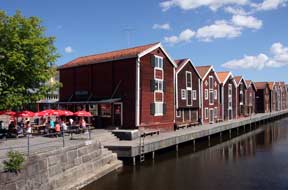 painter in 1796. The Baroque gilded pulpit was reported to
display on its steps a replica of one of the Russian cannon balls from the
1721 bombardment which had been embedded in the church wall. Hesitantly we
searched but, unable to find it, we asked one of the parishioners; this lady
spoke perfect English having lived in England for a time and showed us around
the church to examine the artwork. In the pulpit at the top of the steps
was the small cannon ball, the rysskulan, which she handed to us, and showed us
the portrait of Nathan Söderblom, Nobel Peace Prize winner, Archbishop of Uppsla
from 1914~31 and born near to Hudiksvall. As a parting gift, she presented us
with a candle as a souvenir of our visit to Hudiksvall, one that will grace our
Christmas lunch table. Down by the red-painted wooden fishing sheds which
lined the now defunct former fishing dock, locals sat in the sunshine at an
ice-cream café by the water's edge (see right) (Photo 34 - Fishing sheds at Hudiksvall's former fishing harbour).
We also sat in a shady little corner to eat our sandwiches under the trees by a
fisherman's statue, the only remaining trace of Hudiksvall's once thriving
fishing industry. As we sat there enjoying the surroundings in the pleasant
sunshine, the lady who had shown us around the church arrived and we chatted
more about Hudiksvall, remarking on the noticeable north~south culture divide in
Sweden; she added that once we crossed the Dalälven river south of Gävle, it
would feel like a different country. Today had been a educative visit to Happy
Hudiksvall and one that we should long remember. painter in 1796. The Baroque gilded pulpit was reported to
display on its steps a replica of one of the Russian cannon balls from the
1721 bombardment which had been embedded in the church wall. Hesitantly we
searched but, unable to find it, we asked one of the parishioners; this lady
spoke perfect English having lived in England for a time and showed us around
the church to examine the artwork. In the pulpit at the top of the steps
was the small cannon ball, the rysskulan, which she handed to us, and showed us
the portrait of Nathan Söderblom, Nobel Peace Prize winner, Archbishop of Uppsla
from 1914~31 and born near to Hudiksvall. As a parting gift, she presented us
with a candle as a souvenir of our visit to Hudiksvall, one that will grace our
Christmas lunch table. Down by the red-painted wooden fishing sheds which
lined the now defunct former fishing dock, locals sat in the sunshine at an
ice-cream café by the water's edge (see right) (Photo 34 - Fishing sheds at Hudiksvall's former fishing harbour).
We also sat in a shady little corner to eat our sandwiches under the trees by a
fisherman's statue, the only remaining trace of Hudiksvall's once thriving
fishing industry. As we sat there enjoying the surroundings in the pleasant
sunshine, the lady who had shown us around the church arrived and we chatted
more about Hudiksvall, remarking on the noticeable north~south culture divide in
Sweden; she added that once we crossed the Dalälven river south of Gävle, it
would feel like a different country. Today had been a educative visit to Happy
Hudiksvall and one that we should long remember.
A night away from the coast at Vevlingestrands
Camping: as a preferable alternative to simply continuing down the E4
to Gävle, our next destination, we had identified an inland loop west to Ljusdal
then SE back towards the coast; to avoid a night at the ghastly-sounding leisure
park
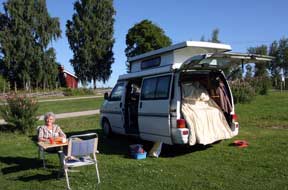 campsite of Feruvik, the Swedish Camping Association campsite listing
showed a site near to Bollnäs from where we could easily reach Gävle for our
visit to the National Railway Museum then continue later in the day on to the
Färnebofjädren National Park. Route 84 westwards from Hudiksvall had a familiar
air; we realised it was the same cross-country road used 6 weeks ago between
Tannäsdalen, Funäsdalen and Hede before turning north to Åre. Today we drove
this road westwards, initially through farming country and increasingly through
timber forests out to Ljusdal, a major stop-off on the north~south railway line
where sidings were filled with wagons awaiting loading with timber stacked in
the timbers yards. We paused to stock with provisions at the ICA supermarket
before turning south to follow the valley of the Ljusdal river on Route 83
running parallel with the main railway line. The road was busy with Sunday
afternoon leisure traffic, and it was noticeable that as we came further south,
so too driving standards degenerated with increasingly aggressive speeding,
tail-gating and impatient overtaking. Not for the first time we said, Oh to be
back in the north again! Just beyond Bollnäs, we found Vevlingestrands Camping
whose lakeside location made it popular with locals as a summer weekend
lake-beach resort. The small lake-side camping area was crammed full but
fortunately a grassy second area terraced up the hill had plenty of space (see
left). It
was noticeable now that dusk was falling earlier and by the time we turned in at
10-30pm, it was pitch dark. campsite of Feruvik, the Swedish Camping Association campsite listing
showed a site near to Bollnäs from where we could easily reach Gävle for our
visit to the National Railway Museum then continue later in the day on to the
Färnebofjädren National Park. Route 84 westwards from Hudiksvall had a familiar
air; we realised it was the same cross-country road used 6 weeks ago between
Tannäsdalen, Funäsdalen and Hede before turning north to Åre. Today we drove
this road westwards, initially through farming country and increasingly through
timber forests out to Ljusdal, a major stop-off on the north~south railway line
where sidings were filled with wagons awaiting loading with timber stacked in
the timbers yards. We paused to stock with provisions at the ICA supermarket
before turning south to follow the valley of the Ljusdal river on Route 83
running parallel with the main railway line. The road was busy with Sunday
afternoon leisure traffic, and it was noticeable that as we came further south,
so too driving standards degenerated with increasingly aggressive speeding,
tail-gating and impatient overtaking. Not for the first time we said, Oh to be
back in the north again! Just beyond Bollnäs, we found Vevlingestrands Camping
whose lakeside location made it popular with locals as a summer weekend
lake-beach resort. The small lake-side camping area was crammed full but
fortunately a grassy second area terraced up the hill had plenty of space (see
left). It
was noticeable now that dusk was falling earlier and by the time we turned in at
10-30pm, it was pitch dark.
The Swedish National Railway Museum at Gävle:
joining Route 50, we headed westwards to reach the E4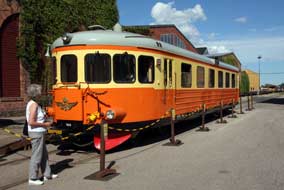 coast highway near to Söderhammn and turned south. Although more than 10kms from the present Bothnian
coastline, the pine forests were dotted with shallow lakes, former bays of the
sea now trapped inland by the land-uplift. Approaching Gävle, we turned off
towards and were guided by the satnav around the central area of the city to
reach the Sveriges Järnvägs Museum (Swedish Railways Museum), our reason for
coming to Gävle. Gävle is Norrland's oldest town founded in 1446, and during the
19th century it became a prosperous industrial centre exporting iron and timber
from its port. After a devastating fire in 1869 the city was rebuilt along
modern lines, its docks and warehouses reflecting the success of its industry.
It is also home to Gevalia Coffee which we had been drinking during the trip.
Care is needed with pronunciation of Gävle's name, Yev-luh, since
mispronunciation could risk confusion with an offensive obscenity! The Swedish
national collection of historical railway locomotives and rolling stock was
moved to Gävle's former engine round-house and workshops in 1970 to form the
railway museum of Sweden administered by Banverket the state-financed national
rail authority. The museum is spread over 2 sites: the former rail depot and
yard here and the main locomotive store at workshops across the city, with a
1950s vintage railcar to transport visitors between the 2 locations. The helpful
lady at the ticket office suggested we begin at the locomotive collection
displayed during the summer months, and we boarded the beautifully preserved
railcar to trundle slowly across the mainline through the central station as
sleek modern railcars streaked past; would one of these be preserved in the
museum collection in 60 years time replaced by goodness knows what?
coast highway near to Söderhammn and turned south. Although more than 10kms from the present Bothnian
coastline, the pine forests were dotted with shallow lakes, former bays of the
sea now trapped inland by the land-uplift. Approaching Gävle, we turned off
towards and were guided by the satnav around the central area of the city to
reach the Sveriges Järnvägs Museum (Swedish Railways Museum), our reason for
coming to Gävle. Gävle is Norrland's oldest town founded in 1446, and during the
19th century it became a prosperous industrial centre exporting iron and timber
from its port. After a devastating fire in 1869 the city was rebuilt along
modern lines, its docks and warehouses reflecting the success of its industry.
It is also home to Gevalia Coffee which we had been drinking during the trip.
Care is needed with pronunciation of Gävle's name, Yev-luh, since
mispronunciation could risk confusion with an offensive obscenity! The Swedish
national collection of historical railway locomotives and rolling stock was
moved to Gävle's former engine round-house and workshops in 1970 to form the
railway museum of Sweden administered by Banverket the state-financed national
rail authority. The museum is spread over 2 sites: the former rail depot and
yard here and the main locomotive store at workshops across the city, with a
1950s vintage railcar to transport visitors between the 2 locations. The helpful
lady at the ticket office suggested we begin at the locomotive collection
displayed during the summer months, and we boarded the beautifully preserved
railcar to trundle slowly across the mainline through the central station as
sleek modern railcars streaked past; would one of these be preserved in the
museum collection in 60 years time replaced by goodness knows what?
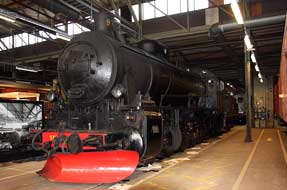 Reaching the sidings by the former rail workshops,
we ventured along the dimly lit bays where preserved locomotives were displayed.
It soon became clear that gathered here was a historic continuum of all the
locomotives used to haul ore trains from Kiruna and Gällivare on the Malmbanan/Ofotbanan
to Narvik and Luleå, right from when the Staten Järnsvägar (State Railways)
first took over the line soon after its 1888 construction. To begin with, Reaching the sidings by the former rail workshops,
we ventured along the dimly lit bays where preserved locomotives were displayed.
It soon became clear that gathered here was a historic continuum of all the
locomotives used to haul ore trains from Kiruna and Gällivare on the Malmbanan/Ofotbanan
to Narvik and Luleå, right from when the Staten Järnsvägar (State Railways)
first took over the line soon after its 1888 construction. To begin with,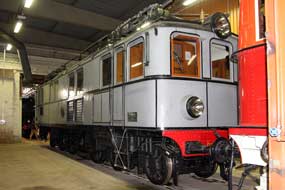 existing freight locomotives were used on the newly opened Malmbanan, and an
example was displayed in the workshop: Jernsida (Iron Sides) was built in
Manchester by Beyer-Peacock in 1860, and it needed a team of 4 of these engines
to haul ore trains. Conventional freight locos like this were wholly inadequate
for conditions on the Malmbanan, and the specially designed Class R 2-10-0 heavy
freight steam locomotive was developed in the first decade of the 20th century
driven by 2 enormous outside cylinders to pull ore trains (see left) (Photo 35 - 1902 steam locomotive for hauling Malmbanan iron ore trains). Soon after,
experiments began with electric traction and the Narvik~Riksgräsen~Narvik ore
line was electrified in 1915 fed from the newly constructed Porjus HEP
generating station. The first successfully operated P Class electric locomotive
was developed in 1914, one of which was displayed, a crude-looking brute of a
beast. Power was picked up from the overhead Hv lines by pantograph, but early
electric traction technology was inadequate to match the power needed to connect
the drive from the motor by toothed gearing. The vehicle was constructed on the
frame-chassis of a steam locomotive with cast wheels, and the drive connected
from the enormous 2m diameter electric motor in the vehicle's body down to the 3
pairs of driving wheels by a heavy coupling rod with the motor turning at the
same rate as the wheels, crude but effective, and the Class P's were highly
existing freight locomotives were used on the newly opened Malmbanan, and an
example was displayed in the workshop: Jernsida (Iron Sides) was built in
Manchester by Beyer-Peacock in 1860, and it needed a team of 4 of these engines
to haul ore trains. Conventional freight locos like this were wholly inadequate
for conditions on the Malmbanan, and the specially designed Class R 2-10-0 heavy
freight steam locomotive was developed in the first decade of the 20th century
driven by 2 enormous outside cylinders to pull ore trains (see left) (Photo 35 - 1902 steam locomotive for hauling Malmbanan iron ore trains). Soon after,
experiments began with electric traction and the Narvik~Riksgräsen~Narvik ore
line was electrified in 1915 fed from the newly constructed Porjus HEP
generating station. The first successfully operated P Class electric locomotive
was developed in 1914, one of which was displayed, a crude-looking brute of a
beast. Power was picked up from the overhead Hv lines by pantograph, but early
electric traction technology was inadequate to match the power needed to connect
the drive from the motor by toothed gearing. The vehicle was constructed on the
frame-chassis of a steam locomotive with cast wheels, and the drive connected
from the enormous 2m diameter electric motor in the vehicle's body down to the 3
pairs of driving wheels by a heavy coupling rod with the motor turning at the
same rate as the wheels, crude but effective, and the Class P's were highly
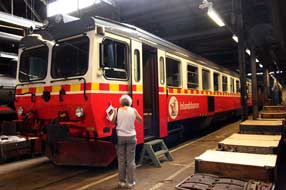 efficient at pulling the heavy ore trains
(see right). By the 1920s cog-gearing technology
improved enabling the drive from electric motors to be coupled indirectly to the
wheels making possible smaller motors to achieve sufficient power to haul the
heavy ore trains on the Malmbanan. One of these locomotives was displayed and
was so successful that it continued until 1948, to be replaced by the sturdy Da
Class electric efficient at pulling the heavy ore trains
(see right). By the 1920s cog-gearing technology
improved enabling the drive from electric motors to be coupled indirectly to the
wheels making possible smaller motors to achieve sufficient power to haul the
heavy ore trains on the Malmbanan. One of these locomotives was displayed and
was so successful that it continued until 1948, to be replaced by the sturdy Da
Class electric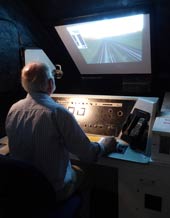 locos, one of which stood in the sidings at the main site
awaiting restoration to take its place in the workshop museum along with its
predecessors on the Malmbanan (Photo 36 - Electric locomotive for hauling Malmbanan iron ore trains). The Da
Class remained in service until replaced by the
Bombardier-built IORE double locos in service today which we had seen in the
north. Among the other displays was one of the Fiat-built railcars which ran on the Inlandsbanan
(see left),
a monster snow-clearance vehicle, and the royal coach used by a succession of
Swedish monarchs since the 1860s. Having during our time in the north learnt so
much about the transportation of iron ore by rail from the mines down to the
port of Narvik, this visit to the National locomotive collection had represented a connection with our earlier travels in Northern Sweden,
a final
link in our historical understanding of Sweden's major export
commodity. locos, one of which stood in the sidings at the main site
awaiting restoration to take its place in the workshop museum along with its
predecessors on the Malmbanan (Photo 36 - Electric locomotive for hauling Malmbanan iron ore trains). The Da
Class remained in service until replaced by the
Bombardier-built IORE double locos in service today which we had seen in the
north. Among the other displays was one of the Fiat-built railcars which ran on the Inlandsbanan
(see left),
a monster snow-clearance vehicle, and the royal coach used by a succession of
Swedish monarchs since the 1860s. Having during our time in the north learnt so
much about the transportation of iron ore by rail from the mines down to the
port of Narvik, this visit to the National locomotive collection had represented a connection with our earlier travels in Northern Sweden,
a final
link in our historical understanding of Sweden's major export
commodity.
We caught the railcar back to the museum's main
site, and just had time for a whistle-stop tour of the exhibition in the former
round-house. Here we learn that one of the 4 finalists in the 1829 Rainhill
locomotive trials for the Liverpool~Manchester Railway, won by Stephenson's
Rocket, was a Swedish engineer, Jan Ericsson with his innovative design
Novelty, a replica of which was displayed. There was just time before
closing for Paul to try his hand driving Sweden's fastest train the high speed
X2000 on a simulator (see right). But with no instructions in English, he managed to crash it into the buffers! A fun experience to
end what had been a worthy afternoon of learning at the Swedish National Railway Museum.
It was now time to extricate ourselves from Gävle's
evening rush hour traffic and head for tonight's campsite in the heart of the
watery Färnebofjärden National Park as the prelude to the next phase of our
travels. But that's for our next episode when we shall report on our time in Sweden's
capital city Stockholm before moving on to its oldest urban foundation Sigtuna
and the beautiful university city of Uppsala. Join us again shortly in the heart of
Sweden.
Next edition
to be published shortly
|
Sheila and Paul |
Published: 4 December 2013 |
|
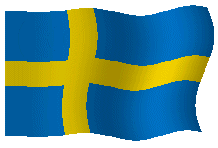
 CAMPING
IN SWEDEN 2013 - south down the Bothnian Coast from Luleå, Piteå, Storforsen
Rapids, Skellefteå, Umeå, High Coast National Park, Sundsvall, Hudiksvall and Gävle:
CAMPING
IN SWEDEN 2013 - south down the Bothnian Coast from Luleå, Piteå, Storforsen
Rapids, Skellefteå, Umeå, High Coast National Park, Sundsvall, Hudiksvall and Gävle: the coast, we found Rörbäcks Camping ranging over a headland among
shore-side pine woods; our beach-side pitch among the pines looked out across
the shallows of the Bothnian Gulf
(Photo 1 - Bothnian Gulf at Rörbäcks Camping). The afternoon sun was still bright, a breeze
off the sea kept any residual midges away, and fully ripe dwarf cornel red berries flourished alongside our pitch
(Photo 2 - Ripe berries of Dwarf Cornel - Cornus suecica). That evening, with the Midnight Sun
period now past, a late dusk settled and a full moon rose over the Baltic Sea
(Photo 3 - Full moon rising over the Bothnian Gulf).
the coast, we found Rörbäcks Camping ranging over a headland among
shore-side pine woods; our beach-side pitch among the pines looked out across
the shallows of the Bothnian Gulf
(Photo 1 - Bothnian Gulf at Rörbäcks Camping). The afternoon sun was still bright, a breeze
off the sea kept any residual midges away, and fully ripe dwarf cornel red berries flourished alongside our pitch
(Photo 2 - Ripe berries of Dwarf Cornel - Cornus suecica). That evening, with the Midnight Sun
period now past, a late dusk settled and a full moon rose over the Baltic Sea
(Photo 3 - Full moon rising over the Bothnian Gulf).  port of Narvik on the Norwegian coast
has taken over in importance, but the university city has become the high-tech industrial centre of
the north specialising in metallurgy.
port of Narvik on the Norwegian coast
has taken over in importance, but the university city has become the high-tech industrial centre of
the north specialising in metallurgy. 
 was now a less
significant port for ore shipment than ice-free Narvik; the port of Luleå at the
head of the Bothnian Gulf is totally blocked by ice in winter making ore
shipment seasonal as well as involving a longer sea voyage from the Baltic. We
drove around a long inner ring-road eventually crossing the railway line where
empty wagons filled the sidings. Beyond this, we could see the huge industrial
outline of a steelworks with its familiar LKAB sign bearing the twin mountain
logo of Luossavarre and Kirunavare AB. We followed the road to its end at a
security gate in a semi-derelict area cleared of its former buildings, where
long overhead conveyors led down to the harbour-side. Security fencing among
trees blocked further view of any dock-side loading, and expecting at any moment
security men to appear demanding explanation of our unauthorised presence on
company property, we returned along the lane to where we could see the gigantic
steelworks beyond the overhead conveyors near the main entrance to the
industrial complex. At a nearby railway bridge a sign by the lines of
hopper-wagons announced the steelworks as LKAB's experimental blast furnace
(see right) where the company worked with steel-making clients on smelting and refining
techniques
(Photo 5 - LKAB steel works at Luleå iron ore terminal). Satisfied that this was the limit of possible views of LKAB's iron
ore terminal, we returned to the city to re-stock with provisions at an ICA
hypermarket.
was now a less
significant port for ore shipment than ice-free Narvik; the port of Luleå at the
head of the Bothnian Gulf is totally blocked by ice in winter making ore
shipment seasonal as well as involving a longer sea voyage from the Baltic. We
drove around a long inner ring-road eventually crossing the railway line where
empty wagons filled the sidings. Beyond this, we could see the huge industrial
outline of a steelworks with its familiar LKAB sign bearing the twin mountain
logo of Luossavarre and Kirunavare AB. We followed the road to its end at a
security gate in a semi-derelict area cleared of its former buildings, where
long overhead conveyors led down to the harbour-side. Security fencing among
trees blocked further view of any dock-side loading, and expecting at any moment
security men to appear demanding explanation of our unauthorised presence on
company property, we returned along the lane to where we could see the gigantic
steelworks beyond the overhead conveyors near the main entrance to the
industrial complex. At a nearby railway bridge a sign by the lines of
hopper-wagons announced the steelworks as LKAB's experimental blast furnace
(see right) where the company worked with steel-making clients on smelting and refining
techniques
(Photo 5 - LKAB steel works at Luleå iron ore terminal). Satisfied that this was the limit of possible views of LKAB's iron
ore terminal, we returned to the city to re-stock with provisions at an ICA
hypermarket. northern lands had been intended by the Swedish
Crown to counter the increasing influence of Imperial Russia. After the break
with Catholicism in 1527, the Swedish clergy were determined to enforce the
fundamentalist Lutheran religion and in 1681 church attendance was made
compulsory by law. The problem in the north was that the colonist Swedish
population and indigenous Sámi were spread over remote distances of the interior
making weekly church attendance impossible. Settlers from the
farmsteads along the river valleys leading into the distant interior were
obliged to attend
northern lands had been intended by the Swedish
Crown to counter the increasing influence of Imperial Russia. After the break
with Catholicism in 1527, the Swedish clergy were determined to enforce the
fundamentalist Lutheran religion and in 1681 church attendance was made
compulsory by law. The problem in the north was that the colonist Swedish
population and indigenous Sámi were spread over remote distances of the interior
making weekly church attendance impossible. Settlers from the
farmsteads along the river valleys leading into the distant interior were
obliged to attend church at Luleå and a large township of church houses grew up
around the church. The trading centre soon became a meeting place
for merchants from the Bothnian Gulf coastal region and settlers from outlying
parts of interior attending church. When the trading centre moved to the new
harbour closer to the river's mouth in 1649, the Church Town remained here
providing shelter for those travelling for their compulsory church attendance.
The present stone church was built originally in the 14th century (see left), its size and
lavish decoration testimony to the region's prosperity based on trade in furs
and salmon fish. But the farming colonisers formed the largest group of the huge
parish which extended onto the mountains and northwards to what is now the
Finnish border. Even during the 20th century, Gammelstad retained its historical
integrity and today 408 cottages survive, crammed together along narrow
alleyways, all still privately owned and with right of occupancy restricted to
those born in Gammelstad. Now the largest of Sweden's surviving church towns,
the Luleå Gammelstad has UNESCO World Heritage status.
church at Luleå and a large township of church houses grew up
around the church. The trading centre soon became a meeting place
for merchants from the Bothnian Gulf coastal region and settlers from outlying
parts of interior attending church. When the trading centre moved to the new
harbour closer to the river's mouth in 1649, the Church Town remained here
providing shelter for those travelling for their compulsory church attendance.
The present stone church was built originally in the 14th century (see left), its size and
lavish decoration testimony to the region's prosperity based on trade in furs
and salmon fish. But the farming colonisers formed the largest group of the huge
parish which extended onto the mountains and northwards to what is now the
Finnish border. Even during the 20th century, Gammelstad retained its historical
integrity and today 408 cottages survive, crammed together along narrow
alleyways, all still privately owned and with right of occupancy restricted to
those born in Gammelstad. Now the largest of Sweden's surviving church towns,
the Luleå Gammelstad has UNESCO World Heritage status. hour wandering around the lanes of tightly packed
red-painted little wooden huts
(Photos 7 and 8 - Wandering the lanes of Gammelstad Church Town), one of which was being re-painted with genuine Falu Rödfärg wood preservative whose manufacture from copper mining waste rock
we had seen many weeks ago at Falun. Beyond the church, we walked down Gamla
Hamngatan (see left) to what had been the site of the original harbour. The bay of Gammelstadsviken which originally gave access to the sheltered port is now
totally sealed off from the Luleälven estuary by land-uplift and all that
remained now was a tiny brook.
hour wandering around the lanes of tightly packed
red-painted little wooden huts
(Photos 7 and 8 - Wandering the lanes of Gammelstad Church Town), one of which was being re-painted with genuine Falu Rödfärg wood preservative whose manufacture from copper mining waste rock
we had seen many weeks ago at Falun. Beyond the church, we walked down Gamla
Hamngatan (see left) to what had been the site of the original harbour. The bay of Gammelstadsviken which originally gave access to the sheltered port is now
totally sealed off from the Luleälven estuary by land-uplift and all that
remained now was a tiny brook.  overwhelmed with traffic noise. The offensively rude
'take-it-or-leave-it' attitude at reception, together with an over-priced
250kr/night cost for a basic site, overwhelmed by traffic noise and with wholly
inadequate and run-down facilities, was symptomatic of holiday-making Bothnian
Coast campsites, Sweden's least attractive region during the summer months,
memorable for all the wrong reasons!
overwhelmed with traffic noise. The offensively rude
'take-it-or-leave-it' attitude at reception, together with an over-priced
250kr/night cost for a basic site, overwhelmed by traffic noise and with wholly
inadequate and run-down facilities, was symptomatic of holiday-making Bothnian
Coast campsites, Sweden's least attractive region during the summer months,
memorable for all the wrong reasons! rapids on the Piteälven
river and camp up there tonight before resuming our southward journey
tomorrow. Turning west onto Route 374 and passing through Piteå's original
site at Öjebyn with its surviving church town, it took only a half hour to reach
the small town of Älvsbyn where we turned off across the wide Piteå River for
diesel and a provisions shop. With our return to warm summer weather after
leaving the Arctic, we also bought charcoal to resume barbecuing in the
evenings. On the edge of the town we found Selholmens
rapids on the Piteälven
river and camp up there tonight before resuming our southward journey
tomorrow. Turning west onto Route 374 and passing through Piteå's original
site at Öjebyn with its surviving church town, it took only a half hour to reach
the small town of Älvsbyn where we turned off across the wide Piteå River for
diesel and a provisions shop. With our return to warm summer weather after
leaving the Arctic, we also bought charcoal to resume barbecuing in the
evenings. On the edge of the town we found Selholmens Camping, a small local
campsite pleasantly terraced up the banks of the river where we should return
this evening. Route 374 westwards was a good road and back in comfortably
forested terrain, we soon reached the lake where the Piteälven turns a sharp 90°
after descending the mighty Storforsen rapids. A side lane ended at an enormous
and almost full car park and at the information centre we were able to buy a
detailed map of the nature walk along the wooden board-walk which ran the length
of the rapids. The Piteälven is one of Sweden's 4 remaining uncontrolled
rivers, whose natural environment is protected by law from the intrusion of
hydro-electric generation exploitation. The rapids at Storforsen are the
greatest natural white-water rapids in the Nordic countries and among Europe's
largest with a total drop of 82m over their 5km course at a point where the
river has over aeons gouged out a channel in the hard granite bed rock. Along
the final and most spectacular 600m, the rapids drop some 50m before the river
resumes its normally placid onward flow. The nature reserve includes sturdy
wooden walk-ways alongside this final 600m section of the falls enabling close
viewing of this spectacular natural phenomenon (see left).
Camping, a small local
campsite pleasantly terraced up the banks of the river where we should return
this evening. Route 374 westwards was a good road and back in comfortably
forested terrain, we soon reached the lake where the Piteälven turns a sharp 90°
after descending the mighty Storforsen rapids. A side lane ended at an enormous
and almost full car park and at the information centre we were able to buy a
detailed map of the nature walk along the wooden board-walk which ran the length
of the rapids. The Piteälven is one of Sweden's 4 remaining uncontrolled
rivers, whose natural environment is protected by law from the intrusion of
hydro-electric generation exploitation. The rapids at Storforsen are the
greatest natural white-water rapids in the Nordic countries and among Europe's
largest with a total drop of 82m over their 5km course at a point where the
river has over aeons gouged out a channel in the hard granite bed rock. Along
the final and most spectacular 600m, the rapids drop some 50m before the river
resumes its normally placid onward flow. The nature reserve includes sturdy
wooden walk-ways alongside this final 600m section of the falls enabling close
viewing of this spectacular natural phenomenon (see left). of the
Dead Falls were now a Blackpool Beach of obese sunbathing bodies sprawled
totally oblivious to the wonders of nature passing with 200m. Thankful that the board-walk alongside the rapids was largely spared this unsavoury intrusion, we
hurried past. With due appreciation of the walk-way's sturdy construction we
stood in amazement looking directly over the point at which the mighty river
tumbled over the brink of the rapids, surging and boiling in foaming fury down
its white-water passage (Photo 10 - Board-walk alongside Storforsen Rapids). We followed the board-walk down to where the rapids
dropped more steeply, the foaming spray creating rainbows in the bright
sunshine (see right) (Photo 11 - Rainbow over Storforsen Rapids), and
of the
Dead Falls were now a Blackpool Beach of obese sunbathing bodies sprawled
totally oblivious to the wonders of nature passing with 200m. Thankful that the board-walk alongside the rapids was largely spared this unsavoury intrusion, we
hurried past. With due appreciation of the walk-way's sturdy construction we
stood in amazement looking directly over the point at which the mighty river
tumbled over the brink of the rapids, surging and boiling in foaming fury down
its white-water passage (Photo 10 - Board-walk alongside Storforsen Rapids). We followed the board-walk down to where the rapids
dropped more steeply, the foaming spray creating rainbows in the bright
sunshine (see right) (Photo 11 - Rainbow over Storforsen Rapids), and from under the pines on the river bank, took endless photos trying
to capture the essence of this spectacular if terrifying embodiment of surging
water power taking place in front of us (Photo 12 - Storforsen Rapids). We later learnt at the information
centre that the board-walk had been replaced 2 years ago after the mighty river,
running in Spring time spate had destroyed the earlier one. During winter, the
entire rapids freeze over. The bitterly cold air is whipped by the foaming water
deep into the river causing it to freeze not on the surface but at the bottom
where ice retards the water flow creating an ice dam; this forces the water out
sideways into the surrounding forest freezing over trees and bushes. Such
freezing over of the rapids in the depths of winter must be an even more
fearsome sight. Mesmerised by the surging water of the rapids, the roaring of
which filled the air at such close quarters (see right), we returned upstream, re-crossing
the water-smoothed rocks and swirl holes of the Dead Falls. The visit to
Storforsen had been a memorable experience, certainly worth the drive up from
the coast. Back at Route 374, leftwards was signed for Jokkmokk, and we would
happily have returned to Lapland rather than face the over-priced campsites of
the Bothnian coast overpopulated with holiday-makers. But with some regrets we
turned right for the return drive to Älvsbyn
from under the pines on the river bank, took endless photos trying
to capture the essence of this spectacular if terrifying embodiment of surging
water power taking place in front of us (Photo 12 - Storforsen Rapids). We later learnt at the information
centre that the board-walk had been replaced 2 years ago after the mighty river,
running in Spring time spate had destroyed the earlier one. During winter, the
entire rapids freeze over. The bitterly cold air is whipped by the foaming water
deep into the river causing it to freeze not on the surface but at the bottom
where ice retards the water flow creating an ice dam; this forces the water out
sideways into the surrounding forest freezing over trees and bushes. Such
freezing over of the rapids in the depths of winter must be an even more
fearsome sight. Mesmerised by the surging water of the rapids, the roaring of
which filled the air at such close quarters (see right), we returned upstream, re-crossing
the water-smoothed rocks and swirl holes of the Dead Falls. The visit to
Storforsen had been a memorable experience, certainly worth the drive up from
the coast. Back at Route 374, leftwards was signed for Jokkmokk, and we would
happily have returned to Lapland rather than face the over-priced campsites of
the Bothnian coast overpopulated with holiday-makers. But with some regrets we
turned right for the return drive to Älvsbyn
 glancing as we passed at the full
length of Storforsen rapids where it descended to the lake for the Piteälven to
continue down valley.
glancing as we passed at the full
length of Storforsen rapids where it descended to the lake for the Piteälven to
continue down valley. sunshine
(see left). As a further indication of this lovely little
campsite's hospitality, the owner's wife came round with a jug of coffee and
tray of home-made cakes. On a beautiful, still evening, we sat looking out over
the river as the sun dipped behind the trees. This was a truly delightful
campsite with a wood-fired sauna included in the price.
sunshine
(see left). As a further indication of this lovely little
campsite's hospitality, the owner's wife came round with a jug of coffee and
tray of home-made cakes. On a beautiful, still evening, we sat looking out over
the river as the sun dipped behind the trees. This was a truly delightful
campsite with a wood-fired sauna included in the price. turning off through the suburbs to park under shady
trees by the domed neo-Classical parish church (see right). Swedish colonists had settled at
the mouth of the Skellefteälven river from the 14th century and a wealthy
trading settlement developed here centred around the parish church built
originally in 1324. The original wooden church was replaced by a larger stone
structure in 1507, the Gothic ogival arches of which can still be seen in the
sacristy of the modern neo-Classical church which was built in 1800 as the
parish grew in size. As at Luleå, a church town (kyrkstad) developed at Bonnstan
next to Skellefteå church with a collection of wooden huts where the travelling
parishioners could spend the night after sitting through lengthy Lutheran
sermons before returning to their distant farms.
turning off through the suburbs to park under shady
trees by the domed neo-Classical parish church (see right). Swedish colonists had settled at
the mouth of the Skellefteälven river from the 14th century and a wealthy
trading settlement developed here centred around the parish church built
originally in 1324. The original wooden church was replaced by a larger stone
structure in 1507, the Gothic ogival arches of which can still be seen in the
sacristy of the modern neo-Classical church which was built in 1800 as the
parish grew in size. As at Luleå, a church town (kyrkstad) developed at Bonnstan
next to Skellefteå church with a collection of wooden huts where the travelling
parishioners could spend the night after sitting through lengthy Lutheran
sermons before returning to their distant farms. he huge, white-painted neo-Classical church
parish (Landskyrka), its large dome supported by 4 sturdy Doric columns on each
of the 4 sides, stood out starkly on the hillside above the Skellefteälven river
on the modern town's western outskirts (Photo 13 - Parish church (Landskyrka) at Skellefteå). The interior had been redesigned in the
1960s with a beautiful modern blue-stained glass rose window inspired by a mill
wheel from the island of Öland added at the east end (see right). But the church's prime
treasures was a collection of medieval carved wooden sculptured artwork of
saints and madonnas now restored to their glory in a small chapel behind the
altar. The pride of the collection was the statuette of the Skellefteå Madonna,
one of few preserved Romanesque images of the Virgin, carved from walnut wood in
Northern Germany in the 12th century (see left). The Child was missing, as were the arms
and hands on all the statuettes; the most likely explanation was their
deliberate removal to allow the carvings to be hidden in a wall cavity from
anti-Catholic vandalism after the State's conversion to puritanical Lutheranism.
The huge graveyard surrounding the church was beautifully tended with neatly
cropped turf and carefully raked gravel pathways. We walked down the lane to
where the Lejonströmsbron wooden bridge dating from 1737 crossed the
Skellefteälven (Photo 14 - 1737 Lejonströmsbron spanning the Skellefteälven). One
he huge, white-painted neo-Classical church
parish (Landskyrka), its large dome supported by 4 sturdy Doric columns on each
of the 4 sides, stood out starkly on the hillside above the Skellefteälven river
on the modern town's western outskirts (Photo 13 - Parish church (Landskyrka) at Skellefteå). The interior had been redesigned in the
1960s with a beautiful modern blue-stained glass rose window inspired by a mill
wheel from the island of Öland added at the east end (see right). But the church's prime
treasures was a collection of medieval carved wooden sculptured artwork of
saints and madonnas now restored to their glory in a small chapel behind the
altar. The pride of the collection was the statuette of the Skellefteå Madonna,
one of few preserved Romanesque images of the Virgin, carved from walnut wood in
Northern Germany in the 12th century (see left). The Child was missing, as were the arms
and hands on all the statuettes; the most likely explanation was their
deliberate removal to allow the carvings to be hidden in a wall cavity from
anti-Catholic vandalism after the State's conversion to puritanical Lutheranism.
The huge graveyard surrounding the church was beautifully tended with neatly
cropped turf and carefully raked gravel pathways. We walked down the lane to
where the Lejonströmsbron wooden bridge dating from 1737 crossed the
Skellefteälven (Photo 14 - 1737 Lejonströmsbron spanning the Skellefteälven). One
 of the oldest and longest wooden bridges in Sweden, it had
been the site of a skirmish between Swedes and Russians in the war of 1741 and
still carries modern traffic, albeit one-way controlled by traffic-lights.
of the oldest and longest wooden bridges in Sweden, it had
been the site of a skirmish between Swedes and Russians in the war of 1741 and
still carries modern traffic, albeit one-way controlled by traffic-lights. our
journey south on the E4 reaching tonight's campsite Lufta Camping just south of
Robertsfors after a half hour's drive.
our
journey south on the E4 reaching tonight's campsite Lufta Camping just south of
Robertsfors after a half hour's drive. charge for residents to plant giving Umeå the
title City of Birch Trees. Today as a university-city with some 30,000 students,
it is demographically a young population with an average age of 37.5 years. The
presence of Norrland University with its teaching hospital attracts people to
the city. Innovative companies in the fields of biotechnology, power engineering
and IT have established themselves here making Umeå a dynamic and fast-growing
region.
charge for residents to plant giving Umeå the
title City of Birch Trees. Today as a university-city with some 30,000 students,
it is demographically a young population with an average age of 37.5 years. The
presence of Norrland University with its teaching hospital attracts people to
the city. Innovative companies in the fields of biotechnology, power engineering
and IT have established themselves here making Umeå a dynamic and fast-growing
region. close to its estuary, the river flowed sluggishly wide. But instead of
the expected attractive riverside gardens, the entire embankment was blocked off
by unsightly building works. Away from this eyesore, we walked to find Umeå's
parish church overlooking the river. The original church built in the mid-17th
century was razed by the Russian army in the 1721 Great Northern War invasion.
The 1725 replacement wooden church was destroyed by fire on Christmas Eve 1887
and the present Neo-Gothic red-brick church consecrated in 1894. Back past
city-centre shops, we walked along the river embankment towards the Gamla Bron;
built in 1863, old it may be but far from attractive. Back through the quiet
city centre, we certainly had not seen Umeå and the banks of the Umeälven at
their best with all the intrusive building work, and did not recall noticing any
of the eponymous birch trees.
close to its estuary, the river flowed sluggishly wide. But instead of
the expected attractive riverside gardens, the entire embankment was blocked off
by unsightly building works. Away from this eyesore, we walked to find Umeå's
parish church overlooking the river. The original church built in the mid-17th
century was razed by the Russian army in the 1721 Great Northern War invasion.
The 1725 replacement wooden church was destroyed by fire on Christmas Eve 1887
and the present Neo-Gothic red-brick church consecrated in 1894. Back past
city-centre shops, we walked along the river embankment towards the Gamla Bron;
built in 1863, old it may be but far from attractive. Back through the quiet
city centre, we certainly had not seen Umeå and the banks of the Umeälven at
their best with all the intrusive building work, and did not recall noticing any
of the eponymous birch trees. picking devices seen
in use last year in Finland? Doubtful where we
could store it in the camper's limited space and whether we should find berries
ripe enough for picking this year, we bought one anyway, and crossing the wide
river, resumed our southward journey. The E4 was busier now but stretches of
dual-carriageway enabled us to pass the slow-moving caravans, and we made good
progress with the 100kms drive down towards Örnsköldsvik and tonight's campsite,
EFS Salbacken described on its website as a 'Christian farm/campsite'; at least
this sounded preferable to the over-priced holiday camps around Umeå. After an
hour and half's tiring drive in the hot afternoon sun, running parallel with the
new Bothnian coast high-speed railway line, we turned off left onto a narrow
single-track lane leading down a coastal peninsula, across an inlet of the sea
and around the shore of the small island of Dekarsön. The lane ended up on a
hill-top at a peaceful campsite overlooking the coast and a warm welcome at
reception. The place was almost empty and the price of 210kr/night included free
washing machine and site-wide wi-fi; this was ideal for our planned rest day
tomorrow, and we gladly settled in (see left). The sky had become hazy and it looked
picking devices seen
in use last year in Finland? Doubtful where we
could store it in the camper's limited space and whether we should find berries
ripe enough for picking this year, we bought one anyway, and crossing the wide
river, resumed our southward journey. The E4 was busier now but stretches of
dual-carriageway enabled us to pass the slow-moving caravans, and we made good
progress with the 100kms drive down towards Örnsköldsvik and tonight's campsite,
EFS Salbacken described on its website as a 'Christian farm/campsite'; at least
this sounded preferable to the over-priced holiday camps around Umeå. After an
hour and half's tiring drive in the hot afternoon sun, running parallel with the
new Bothnian coast high-speed railway line, we turned off left onto a narrow
single-track lane leading down a coastal peninsula, across an inlet of the sea
and around the shore of the small island of Dekarsön. The lane ended up on a
hill-top at a peaceful campsite overlooking the coast and a warm welcome at
reception. The place was almost empty and the price of 210kr/night included free
washing machine and site-wide wi-fi; this was ideal for our planned rest day
tomorrow, and we gladly settled in (see left). The sky had become hazy and it looked as if
a storm was approaching from the High Coast which we could just make out in the
misty distance down the coast, and checking the forecast later, the weather
looked grim for the next few days. The stormy haze passed, but evening brought
an early, dewy dusk and by 10-30pm it was fully dark.
as if
a storm was approaching from the High Coast which we could just make out in the
misty distance down the coast, and checking the forecast later, the weather
looked grim for the next few days. The stormy haze passed, but evening brought
an early, dewy dusk and by 10-30pm it was fully dark. Örnsköldsvik, gateway to the High coast:
approaching Örnsköldsvik from the Dekarsön lane, it was clear that the town was
larger than expected with major industry and a large pulp and paper mill on the
far side of the bay. We found street parking close to the centre and the TIC in
the town library helpfully provided free maps for walks in the High Coast
National Park and good advice on routes. Traffic on the E4 which passes through
the town was intensely busy, the worst driving standards yet experienced in
Sweden, as we set off south from Örnsköldsvik in heavily overcast weather. The
terrain became wilder with rolling, forested hills but we could see little of it
in the gloomy clinging mist, and the aggressive traffic demanded full attention. We
passed the turning at Bjästa for the northern start-point for the High Coast
(Höga Kusten) walks and began the long haul where the E4 crosses the shoulder of the High
Coast's hilly land. It would have been spectacular countryside had we been able
to see it! The came the startlingly long descent of the southern side of the
hills with traffic building up behind slow-moving trucks. Even if the weather
had been clear, this volume of impatiently aggressive traffic on the steep,
lengthy hill made this feel a particularly hazardous stretch of road. At the
foot of the hill approaching Docksta, we were glad to pull into the High Coast
National Park Naturum which was overshadowed by the hill of Skuleberget. There
was however little impression of the hill's height with the totally enshrouding
misty cloud. We reached the Centre just in time for the English-language
presentation on the geomorphological background to the High Coast's unique
formation by the process of post-glacial isostatic land uplift.
Örnsköldsvik, gateway to the High coast:
approaching Örnsköldsvik from the Dekarsön lane, it was clear that the town was
larger than expected with major industry and a large pulp and paper mill on the
far side of the bay. We found street parking close to the centre and the TIC in
the town library helpfully provided free maps for walks in the High Coast
National Park and good advice on routes. Traffic on the E4 which passes through
the town was intensely busy, the worst driving standards yet experienced in
Sweden, as we set off south from Örnsköldsvik in heavily overcast weather. The
terrain became wilder with rolling, forested hills but we could see little of it
in the gloomy clinging mist, and the aggressive traffic demanded full attention. We
passed the turning at Bjästa for the northern start-point for the High Coast
(Höga Kusten) walks and began the long haul where the E4 crosses the shoulder of the High
Coast's hilly land. It would have been spectacular countryside had we been able
to see it! The came the startlingly long descent of the southern side of the
hills with traffic building up behind slow-moving trucks. Even if the weather
had been clear, this volume of impatiently aggressive traffic on the steep,
lengthy hill made this feel a particularly hazardous stretch of road. At the
foot of the hill approaching Docksta, we were glad to pull into the High Coast
National Park Naturum which was overshadowed by the hill of Skuleberget. There
was however little impression of the hill's height with the totally enshrouding
misty cloud. We reached the Centre just in time for the English-language
presentation on the geomorphological background to the High Coast's unique
formation by the process of post-glacial isostatic land uplift. The High coast's formation by post-glacial land
uplift: During the last Ice Age (Weichsel), the ice-sheet covering
Northern Europe reached its maximum depth of 3kms around 20,000 years ago. The
massive weight of this 3km deep ice-sheet depressed the earth's outer crust by
up to 1000m around the area of the High Coast. As the earth's climate warmed
around 10,000 years ago, the Ice Age glacial sheet retreated towards the
interior of Northern Sweden as the ice melted. Relieved of the weight and
pressure of the ice-sheet, the land began to rise again, relatively quickly at
first at a rate of 10cms a year (10m every 100 years), with the rate of uplift
fastest where the depression of the land had been greatest around the High
Coast. When the margin of the ice-sheet had retreated NW of the High Coast
around 9,600 year ago, the area had already risen almost 500m from its lowest
level of depression; since then the land has risen an additional 300m for a
total of 800m from its lowest to current levels. The land is still rising but at
a slower rate of 8mm/year (1m/century) and assuming no other global changes
intervene (eg a further Ice Age or sea level changes due to polar ice melting),
it will take a further 10,000 years for the earth's crust to re-assert its
pre-glacial level. As a result of this final phase of post-glacial isostatic
uplift, the Bothnian Gulf at its northern end will have become so shallow that
by then Sweden and Finland will be joined by a land-bridge.
The High coast's formation by post-glacial land
uplift: During the last Ice Age (Weichsel), the ice-sheet covering
Northern Europe reached its maximum depth of 3kms around 20,000 years ago. The
massive weight of this 3km deep ice-sheet depressed the earth's outer crust by
up to 1000m around the area of the High Coast. As the earth's climate warmed
around 10,000 years ago, the Ice Age glacial sheet retreated towards the
interior of Northern Sweden as the ice melted. Relieved of the weight and
pressure of the ice-sheet, the land began to rise again, relatively quickly at
first at a rate of 10cms a year (10m every 100 years), with the rate of uplift
fastest where the depression of the land had been greatest around the High
Coast. When the margin of the ice-sheet had retreated NW of the High Coast
around 9,600 year ago, the area had already risen almost 500m from its lowest
level of depression; since then the land has risen an additional 300m for a
total of 800m from its lowest to current levels. The land is still rising but at
a slower rate of 8mm/year (1m/century) and assuming no other global changes
intervene (eg a further Ice Age or sea level changes due to polar ice melting),
it will take a further 10,000 years for the earth's crust to re-assert its
pre-glacial level. As a result of this final phase of post-glacial isostatic
uplift, the Bothnian Gulf at its northern end will have become so shallow that
by then Sweden and Finland will be joined by a land-bridge. the
young staff at the restaurant which served as campsite reception, and were
pleasantly surprised at the reasonable price of 200kr/night all in including
wi-fi. But there was no avoiding the slope to find a flattish pitch and no
escaping the ever-present traffic noise, and the low mist down to tree-top
levels gave a depressingly gloomy air. The low mist clung on the following
morning and with rain threatening, this was no weather for walking in the High
Coast; another day in camp was the best use of time and we battened down for a
day of writing and researching options for boat rides out to the off-shore
islands. The mist got wetter finally turning to rain, wetter than at any other
point of the trip. We seemed enveloped in wet, misty cloud making everything
feel damp, but a late afternoon weather check forecast a more optimistic change
to sunnier conditions tomorrow. But with this wet, gloomy cloud stuck over us
with stagnant air and no wind to shift it, this seemed hard to believe; with rain
still pouring and the heater on full, we were thankful to be snug, dry and
comfortably warm inside George (see left). We had been carefully managing our
limited supplies of Camping Gaz by using campsite kitchens wherever possible.
But tonight, as we cooked a warming supper of meatballs in lingonberry sauce in
pouring rain, Sod's Law dictated that this was just the weather for our
first gas cylinder to run out; it did of course, meaning a wet change of gas
bottle!
the
young staff at the restaurant which served as campsite reception, and were
pleasantly surprised at the reasonable price of 200kr/night all in including
wi-fi. But there was no avoiding the slope to find a flattish pitch and no
escaping the ever-present traffic noise, and the low mist down to tree-top
levels gave a depressingly gloomy air. The low mist clung on the following
morning and with rain threatening, this was no weather for walking in the High
Coast; another day in camp was the best use of time and we battened down for a
day of writing and researching options for boat rides out to the off-shore
islands. The mist got wetter finally turning to rain, wetter than at any other
point of the trip. We seemed enveloped in wet, misty cloud making everything
feel damp, but a late afternoon weather check forecast a more optimistic change
to sunnier conditions tomorrow. But with this wet, gloomy cloud stuck over us
with stagnant air and no wind to shift it, this seemed hard to believe; with rain
still pouring and the heater on full, we were thankful to be snug, dry and
comfortably warm inside George (see left). We had been carefully managing our
limited supplies of Camping Gaz by using campsite kitchens wherever possible.
But tonight, as we cooked a warming supper of meatballs in lingonberry sauce in
pouring rain, Sod's Law dictated that this was just the weather for our
first gas cylinder to run out; it did of course, meaning a wet change of gas
bottle!
 The
path to Slåttdalsskrevan Gorge: the serious height gain now began, a
gruellingly unremitting slog up through the pines on a steep path poor underfoot
with tree-roots and boulders, and under dense forest cover wet from yesterday's
rain. The only distractions from the tedium of this upwards haul were the clumps
of light grey-green Beard-lichen (Usnea longissima) hanging on the pine
branches (see right). This rare species of epiphytic lichen, associated with ancient forests
with high,
The
path to Slåttdalsskrevan Gorge: the serious height gain now began, a
gruellingly unremitting slog up through the pines on a steep path poor underfoot
with tree-roots and boulders, and under dense forest cover wet from yesterday's
rain. The only distractions from the tedium of this upwards haul were the clumps
of light grey-green Beard-lichen (Usnea longissima) hanging on the pine
branches (see right). This rare species of epiphytic lichen, associated with ancient forests
with high,
 even humidity, features on the Höga Kusten/Skuleskogens
National Park emblem along with the Slåttdalsskrevan Gorge (see left). The
other attraction was picking the ripe, juicy bilberries that carpeted the forest
floor when we paused frequently for breath. The path flattened along a shelf
above the rapidly flowing Skravelbäcken torrent cascading down the hill-slope,
and crossed on a wooden footbridge to climb steeply up the wet, rocky far bank
and continue ahead, shelving round through the pines to gain further height
(Photo 16 - Walking in High Coast National Park).
This next section of path was even more impeded by tangled tree roots and
rounded bounded boulders, the remains of ancient beaches pre-dating the
land-uplift; however interesting geologically, the ever-rising path through the
dark and featureless pine woods needed constant attention to avoid slipping on
the wet boulders or twisting an ankle on the snaring tree roots. Eventually we
reached the smaller of the 2 Tärnättvattnen lakes, once a bay of the sea when
the ice first melted and before the land rose to isolate them. Passing the lake
with the sun sparkling on the water and a distant first glimpse of the Slåttdalsskrevan
Gorge on the skyline, bright red clumps of dwarf cornel berries grew among the
boulders along the lake shore. Board-walks led across the intervening 200m of
marshy ground to reach the larger lake, and here at the meeting of paths a number
of walkers gathered. There was now a clearer view of the still distant gorge,
but we still had much height to gain.
even humidity, features on the Höga Kusten/Skuleskogens
National Park emblem along with the Slåttdalsskrevan Gorge (see left). The
other attraction was picking the ripe, juicy bilberries that carpeted the forest
floor when we paused frequently for breath. The path flattened along a shelf
above the rapidly flowing Skravelbäcken torrent cascading down the hill-slope,
and crossed on a wooden footbridge to climb steeply up the wet, rocky far bank
and continue ahead, shelving round through the pines to gain further height
(Photo 16 - Walking in High Coast National Park).
This next section of path was even more impeded by tangled tree roots and
rounded bounded boulders, the remains of ancient beaches pre-dating the
land-uplift; however interesting geologically, the ever-rising path through the
dark and featureless pine woods needed constant attention to avoid slipping on
the wet boulders or twisting an ankle on the snaring tree roots. Eventually we
reached the smaller of the 2 Tärnättvattnen lakes, once a bay of the sea when
the ice first melted and before the land rose to isolate them. Passing the lake
with the sun sparkling on the water and a distant first glimpse of the Slåttdalsskrevan
Gorge on the skyline, bright red clumps of dwarf cornel berries grew among the
boulders along the lake shore. Board-walks led across the intervening 200m of
marshy ground to reach the larger lake, and here at the meeting of paths a number
of walkers gathered. There was now a clearer view of the still distant gorge,
but we still had much height to gain. had been eroded
away leaving the gorge between high walls of the harder, more resistant granite.
We stood there in awe looking up this dark groove with the sun shining down the
gorge from its head at the southern end (Photo 18 - View from foot of Slåttdalsskrevan Gorge). Water dripped from the dank side-wall
that was in permanent shade while sunlight lit the opposite face (see left). The bed of the
gorge, which sloped upwards at a steep angle, was littered with red granite
had been eroded
away leaving the gorge between high walls of the harder, more resistant granite.
We stood there in awe looking up this dark groove with the sun shining down the
gorge from its head at the southern end (Photo 18 - View from foot of Slåttdalsskrevan Gorge). Water dripped from the dank side-wall
that was in permanent shade while sunlight lit the opposite face (see left). The bed of the
gorge, which sloped upwards at a steep angle, was littered with red granite boulders made treacherously slippery by water running down the enclosed slope.
Gingerly we made our way upwards, and at the top a steep wooden step-ladder led
to the very lip of the gorge where we emerged onto the narrow watershed where
the High Coast path descended even more steeply on the southern side. A number
of other walkers were also gathered here making the narrow, confined col a very
crowded little spot. The view looking back down into the gorge from the
watershed emphasised the
impressive height of its sheer, vertical red granite enclosing walls, but the
harsh contrast of light and shade made it difficult to achieve a photograph
which did justice to this stunning setting (Photo 19 - Looking down Slåttdalsskrevan Gorge from watershed). We signed the visitor book and
geared up for the descent, dropping back down the ladder to negotiate the steep
and treacherously slippery slabs and boulders down the 100m length of the gorge,
back into the trees at the bottom. After a snack pause on the rocky plateau
looking out to the distant sea beyond the Höga Kusten forests and lakes (see
right), we
began the long and wearying return walk down through the pine forests.
boulders made treacherously slippery by water running down the enclosed slope.
Gingerly we made our way upwards, and at the top a steep wooden step-ladder led
to the very lip of the gorge where we emerged onto the narrow watershed where
the High Coast path descended even more steeply on the southern side. A number
of other walkers were also gathered here making the narrow, confined col a very
crowded little spot. The view looking back down into the gorge from the
watershed emphasised the
impressive height of its sheer, vertical red granite enclosing walls, but the
harsh contrast of light and shade made it difficult to achieve a photograph
which did justice to this stunning setting (Photo 19 - Looking down Slåttdalsskrevan Gorge from watershed). We signed the visitor book and
geared up for the descent, dropping back down the ladder to negotiate the steep
and treacherously slippery slabs and boulders down the 100m length of the gorge,
back into the trees at the bottom. After a snack pause on the rocky plateau
looking out to the distant sea beyond the Höga Kusten forests and lakes (see
right), we
began the long and wearying return walk down through the pine forests. The off-shore High Coast island of Trysunda:
returning to the little harbour Köpmanholmen, we found the car park almost full,
either day-visitors on the 9-00am boat to the larger island of Ulvön or seasonal
summer residents on the islands. We had arrived early to ensure seats on the
boat over to Trysunda but the jetty was almost deserted. While waiting for
the M/S Minerva, we got into conversation with a charming Swedish couple
who lived in Kalix near
The off-shore High Coast island of Trysunda:
returning to the little harbour Köpmanholmen, we found the car park almost full,
either day-visitors on the 9-00am boat to the larger island of Ulvön or seasonal
summer residents on the islands. We had arrived early to ensure seats on the
boat over to Trysunda but the jetty was almost deserted. While waiting for
the M/S Minerva, we got into conversation with a charming Swedish couple
who lived in Kalix near
 Haparanda in the Finnish borderlands during the winter
but had a summer cottage on Ulvön to where they were now returning laden with
shopping and 10 litre drums of Falu Rödfärg preservative for painting their
cottage's woodwork. We remarked on this saying we had seen the Rödfärg factory
while visiting the copper mines at Falun earlier in our trip (
Haparanda in the Finnish borderlands during the winter
but had a summer cottage on Ulvön to where they were now returning laden with
shopping and 10 litre drums of Falu Rödfärg preservative for painting their
cottage's woodwork. We remarked on this saying we had seen the Rödfärg factory
while visiting the copper mines at Falun earlier in our trip ( ("Just ask for us by name" they said,
"Anyone will know where we live"), we clambered ashore on the tiny jetty as the
ferry pulled away to continue on to Ulvön. From the jetty, we set off along the
footpath behind the harbour-front cottages around the head of the narrow inlet
looking out across to the tiny fishing village with its red-painted houses. A
rocky outcrop
("Just ask for us by name" they said,
"Anyone will know where we live"), we clambered ashore on the tiny jetty as the
ferry pulled away to continue on to Ulvön. From the jetty, we set off along the
footpath behind the harbour-front cottages around the head of the narrow inlet
looking out across to the tiny fishing village with its red-painted houses. A
rocky outcrop with a look-out atop looked down over the inlet harbour (see left); from this
paradise garden of creeping bearberry with residual bell-shaped flowers and
ripening berries carpeting the rocks, and crowberry with shiny black fruits, the
view down the length of Trysunda's remaining inlet would have been splendid but
for the sea mist now making the little harbour gloomy (Photo 21 - Trysunda village and harbour in misty weather). A path led through woods
along what once would have been Trysunda's second sound over to the cobbled
boulder field of Storviken beach, but the mist was down to sea level making it
difficult to photograph the circuit of wave-polished boulders (see right). It was an eerily
beautiful spot in the gloomy sea mist as we sat on the rocks to eat our
sandwiches looking across the bay. From the boulder beach, a further path turned
steeply up into a narrow valley which would once have been the first of the
former sounds to disappear with the land-uplift. Now carpeted with lichen and
bilberry, the path zigzagged over to Björnviken with its beautiful wild beach of
fine white sand (Photo 22 - Sea mist over Björnviken white sand beach), the dunes behind the beach covered with marram grass and
sweetly scented wild roses (Photo 23 - Wild Roses growing by Björnviken beach).
Again the sea mist prevented this wild setting being seen at its glorious best.
with a look-out atop looked down over the inlet harbour (see left); from this
paradise garden of creeping bearberry with residual bell-shaped flowers and
ripening berries carpeting the rocks, and crowberry with shiny black fruits, the
view down the length of Trysunda's remaining inlet would have been splendid but
for the sea mist now making the little harbour gloomy (Photo 21 - Trysunda village and harbour in misty weather). A path led through woods
along what once would have been Trysunda's second sound over to the cobbled
boulder field of Storviken beach, but the mist was down to sea level making it
difficult to photograph the circuit of wave-polished boulders (see right). It was an eerily
beautiful spot in the gloomy sea mist as we sat on the rocks to eat our
sandwiches looking across the bay. From the boulder beach, a further path turned
steeply up into a narrow valley which would once have been the first of the
former sounds to disappear with the land-uplift. Now carpeted with lichen and
bilberry, the path zigzagged over to Björnviken with its beautiful wild beach of
fine white sand (Photo 22 - Sea mist over Björnviken white sand beach), the dunes behind the beach covered with marram grass and
sweetly scented wild roses (Photo 23 - Wild Roses growing by Björnviken beach).
Again the sea mist prevented this wild setting being seen at its glorious best.  The path continued northwards under the island's
central knoll of Kapellsberget around to Rödskatevik, a more open beach lined
with red granite rocks and of course gritty red sand, and by now the mist was
beginning to lift and a weak sun shining through. We continued back through the
woods past the village graveyard around to the tiny wooden chapel built in 1654
by the island's first residents, fishermen from Gävle who used it during the
winter months to store their nets. Although the chapel
The path continued northwards under the island's
central knoll of Kapellsberget around to Rödskatevik, a more open beach lined
with red granite rocks and of course gritty red sand, and by now the mist was
beginning to lift and a weak sun shining through. We continued back through the
woods past the village graveyard around to the tiny wooden chapel built in 1654
by the island's first residents, fishermen from Gävle who used it during the
winter months to store their nets. Although the chapel was locked, a large key
hung conveniently on a hook by the door (see left); inside the walls were covered with straightforward
rustic paintings including St George skewering a large dragon up on the west end
gable (Photo 24 - Trysunda's 17th century wooden church). The paintings had been made in 1711, the year in which King Karl XII
built a naval base at Trysunda; the artist was probably a craftsman on one of
the warships and like many of his fellow sailors came from Finland. After a walk
around the northern harbour-side and along the third former sound to another
small cove, we returned to Trysunda village stopping at one of the cottages
which advertised home-made Surströmming. The lady told us more about this local
specialty, again stressing the importance of storing the tin in the fridge to delay the
fermentation and opening it outdoors because of its foul stench; asked if she
like Surströmming, she replied "Certainly not, but no one has died of it yet!"
With grave reservations, we felt we should at least try it. Back around to the
jetty we waited for the boat self-consciously clutching our tin of Surströmming,
and with the sun now lighting the lovely red cottages around the narrow harbour
inlet we clambered aboard the M/S Ulvön (Photo 25 - Trysunda village and harbour). Passing the uninhabited islet of
Skrubban with its bird nesting cliffs, the boat made good progress back to Köpmanholmen.
was locked, a large key
hung conveniently on a hook by the door (see left); inside the walls were covered with straightforward
rustic paintings including St George skewering a large dragon up on the west end
gable (Photo 24 - Trysunda's 17th century wooden church). The paintings had been made in 1711, the year in which King Karl XII
built a naval base at Trysunda; the artist was probably a craftsman on one of
the warships and like many of his fellow sailors came from Finland. After a walk
around the northern harbour-side and along the third former sound to another
small cove, we returned to Trysunda village stopping at one of the cottages
which advertised home-made Surströmming. The lady told us more about this local
specialty, again stressing the importance of storing the tin in the fridge to delay the
fermentation and opening it outdoors because of its foul stench; asked if she
like Surströmming, she replied "Certainly not, but no one has died of it yet!"
With grave reservations, we felt we should at least try it. Back around to the
jetty we waited for the boat self-consciously clutching our tin of Surströmming,
and with the sun now lighting the lovely red cottages around the narrow harbour
inlet we clambered aboard the M/S Ulvön (Photo 25 - Trysunda village and harbour). Passing the uninhabited islet of
Skrubban with its bird nesting cliffs, the boat made good progress back to Köpmanholmen. Bridge is the 3rd
longest, UK's Humber Bridge the 7th longest, and San Francisco's Golden Gate
Bridge the 12th longest). Just beyond the bridge, we took a side turning for
3kms to Snibbens Camping, a lake-side campsite packed full of caravans. The
owners found us a space on a flat headland overlooking Lake Mörtsjön; in spite
of the inevitable noise, this was the best we could hope for in the peak holiday
season and later that evening we were treated to a glorious sunset across the
lake with the entire western sky lit by a golden ruddy glow (Photo 26 - Sunset over Lake Mörtsjön). The following
morning with a clear sun and sky reflected on the lake's blue waters, we
returned across the High Coast Bridge and pulled off at the northern end
into a parking area; here with ancient pines in the foreground was the finest
photographic angle down the length of this magnificent bridge (Photo 27 - Höga-kustenbron (High Coast Bridge) spanning Ångermanälven river).
Bridge is the 3rd
longest, UK's Humber Bridge the 7th longest, and San Francisco's Golden Gate
Bridge the 12th longest). Just beyond the bridge, we took a side turning for
3kms to Snibbens Camping, a lake-side campsite packed full of caravans. The
owners found us a space on a flat headland overlooking Lake Mörtsjön; in spite
of the inevitable noise, this was the best we could hope for in the peak holiday
season and later that evening we were treated to a glorious sunset across the
lake with the entire western sky lit by a golden ruddy glow (Photo 26 - Sunset over Lake Mörtsjön). The following
morning with a clear sun and sky reflected on the lake's blue waters, we
returned across the High Coast Bridge and pulled off at the northern end
into a parking area; here with ancient pines in the foreground was the finest
photographic angle down the length of this magnificent bridge (Photo 27 - Höga-kustenbron (High Coast Bridge) spanning Ångermanälven river).
 governor's residence lining its western side.
Armed with a town plan from the TIC, we walked around the centre to find the
1840 Domkyrkan, the country's smallest cathedral, and nearby the 18th century
wooden cottages of Östanbäcksgan, before resuming our journey south.
governor's residence lining its western side.
Armed with a town plan from the TIC, we walked around the centre to find the
1840 Domkyrkan, the country's smallest cathedral, and nearby the 18th century
wooden cottages of Östanbäcksgan, before resuming our journey south. wealthy trading centre on the Bothnian coast particularly for timber export
from its port. But at midsummer 1888, the worst ever fire, started from a
wood-burning steam-boat, destroyed the entire town with 9,000 houses burnt down.
Such however was the town's wealth that within 10 years Sundsvall was rebuilt
constructed wholly from stone by Stockholm's leading architects with wide
streets and esplanades as fire breaks. The town centre today shows this turn of
20th century grandiose urban architecture giving Sundsvall the sobriquet of
Stenstaden (Stone City). To make way for the new city, its working classes
were moved from their old homes in the centre to cramped areas in the outskirts,
a stark contrast between affluence and impoverishment.
wealthy trading centre on the Bothnian coast particularly for timber export
from its port. But at midsummer 1888, the worst ever fire, started from a
wood-burning steam-boat, destroyed the entire town with 9,000 houses burnt down.
Such however was the town's wealth that within 10 years Sundsvall was rebuilt
constructed wholly from stone by Stockholm's leading architects with wide
streets and esplanades as fire breaks. The town centre today shows this turn of
20th century grandiose urban architecture giving Sundsvall the sobriquet of
Stenstaden (Stone City). To make way for the new city, its working classes
were moved from their old homes in the centre to cramped areas in the outskirts,
a stark contrast between affluence and impoverishment. On a sunny afternoon, we walked along the wide
Esplanaden through to Stortorget photographing the grandiose buildings and
parklands (Photo 28 - Sundvall's delightful city centre). Scattered around the centre small colourful dragon statues stood at
street corners, each numbered with its sponsoring company's plaque their fiery
breath recalling the disastrous fire of 1888. Each summer a competition is held
to elect the most popular of these colourful dragon statues (see left). Sundsvall's Stortorget, the large, open main square is lined with grandiose buildings and in the centre a statue of Gustav II Adolfus gazes regally over the town he
founded (Photo 29 - Gustav II Adolfus's statue in Sundall's central square). At the TIC in the rådhus we picked up a town plan and voted in the
dragon competition for Häsbe and Erica the ICA dragon; though we shall never
know the 2013 result, it was all good fun. After a walk up Kyrkogatan past the
town's grand restoration buildings to see the late 19th century Gustav Adolfs
kyrkan, we returned through the centre viewing more of the dragons for a brief
visit to the Kulturmagazinet museum and admire the glazed-in structure of the
restored warehouses. The English language leaflet accompanying the City that
Changed exhibition told the story of Sundall's prosperity as a trading
centre and the town's post-1888 great fire stone restoration. This had been a
thoroughly enjoyable afternoon ambling around this delightful city in the
sunshine, but we now had a long drive ahead to reach tonight's campsite near to
Hudiksvall
On a sunny afternoon, we walked along the wide
Esplanaden through to Stortorget photographing the grandiose buildings and
parklands (Photo 28 - Sundvall's delightful city centre). Scattered around the centre small colourful dragon statues stood at
street corners, each numbered with its sponsoring company's plaque their fiery
breath recalling the disastrous fire of 1888. Each summer a competition is held
to elect the most popular of these colourful dragon statues (see left). Sundsvall's Stortorget, the large, open main square is lined with grandiose buildings and in the centre a statue of Gustav II Adolfus gazes regally over the town he
founded (Photo 29 - Gustav II Adolfus's statue in Sundall's central square). At the TIC in the rådhus we picked up a town plan and voted in the
dragon competition for Häsbe and Erica the ICA dragon; though we shall never
know the 2013 result, it was all good fun. After a walk up Kyrkogatan past the
town's grand restoration buildings to see the late 19th century Gustav Adolfs
kyrkan, we returned through the centre viewing more of the dragons for a brief
visit to the Kulturmagazinet museum and admire the glazed-in structure of the
restored warehouses. The English language leaflet accompanying the City that
Changed exhibition told the story of Sundall's prosperity as a trading
centre and the town's post-1888 great fire stone restoration. This had been a
thoroughly enjoyable afternoon ambling around this delightful city in the
sunshine, but we now had a long drive ahead to reach tonight's campsite near to
Hudiksvall suggested an overcrowded campsite, and
we phoned the alternative Hölick Havsresort; the very name should have alerted
us to this major error. But it was close to the Hornslandet peninsula nature
reserve where we wanted to walk, they could supply us with maps and walking
route details, and supposedly had spaces, and we set off across the peninsula.
Only on our arrival did we discover our misjudgement: here among the pine woods
was a sordidly overcrowded bedlam, with every square centimetre crammed full of
caravans, mind-numbing noise levels, and charging 270kr/night for the privilege
of staying in this hell-hole. Doggedly weary after an otherwise enjoyable day
and with no option but to grin and bear it tonight, we settled in and resorted
to nature's panacea for all woes, a cold beer, but even this failed us in these
desperate circumstances! Doubtless in May or October the pine woods surroundings
of this place would be deserted; but in the summer holiday period this was an
absolute NO-NO to be avoided at all costs!
suggested an overcrowded campsite, and
we phoned the alternative Hölick Havsresort; the very name should have alerted
us to this major error. But it was close to the Hornslandet peninsula nature
reserve where we wanted to walk, they could supply us with maps and walking
route details, and supposedly had spaces, and we set off across the peninsula.
Only on our arrival did we discover our misjudgement: here among the pine woods
was a sordidly overcrowded bedlam, with every square centimetre crammed full of
caravans, mind-numbing noise levels, and charging 270kr/night for the privilege
of staying in this hell-hole. Doggedly weary after an otherwise enjoyable day
and with no option but to grin and bear it tonight, we settled in and resorted
to nature's panacea for all woes, a cold beer, but even this failed us in these
desperate circumstances! Doubtless in May or October the pine woods surroundings
of this place would be deserted; but in the summer holiday period this was an
absolute NO-NO to be avoided at all costs! The Hornslandet peninsula nature reserve and
Hölick fishing village: after a grim, sleepless night of screaming
dogs, yapping kids, raucous holiday-makers and blaring TVs, we took stock: we
should leave the holiday hoards to their beaches, enjoy a day's walking in the
peaceful Hornslandet peninsula, then move back to the comparatively civilised
Malnbadens Camping tonight before visiting Hudiksvall tomorrow and moving on to Gävle. Never had we been so glad to be packing up; our spirits rose as we drove
away and parked around the corner ready for today's walk around the Hornslandet
peninsula nature reserve. The path we planned to follow was well-marked and
began as a forest trail through pine woods, continuing alongside beautifully
peaceful pine-fringed pebble beaches with the blue sea sparkling in the morning
sunshine. The forest edge was densely carpeted with bearberry, its luxuriant
growth creeping down into the sandy shore. Tiny patches of ripening red
lingonberry and scented tufts of ling grew among the bearberries under the
pines. Higher up across the pebbly beach, there were more classic examples of
tiered raised beach boulder fields. Revelling in the peacefulness of this
pine-fringed coastline, we paused for our sandwich lunch sat among the pebbles
looking out to the sparkling sea (Photo 30 - Lunch on a raised beach at Hornslandet peninsula). The marked path turned inland up across the
raised beach boulder fields into the pine forest to reach a junction from where
a path with good surface of sand and pine needles sloped downwards to our start
point amid the peacefulness of glorious woodland flora.
The Hornslandet peninsula nature reserve and
Hölick fishing village: after a grim, sleepless night of screaming
dogs, yapping kids, raucous holiday-makers and blaring TVs, we took stock: we
should leave the holiday hoards to their beaches, enjoy a day's walking in the
peaceful Hornslandet peninsula, then move back to the comparatively civilised
Malnbadens Camping tonight before visiting Hudiksvall tomorrow and moving on to Gävle. Never had we been so glad to be packing up; our spirits rose as we drove
away and parked around the corner ready for today's walk around the Hornslandet
peninsula nature reserve. The path we planned to follow was well-marked and
began as a forest trail through pine woods, continuing alongside beautifully
peaceful pine-fringed pebble beaches with the blue sea sparkling in the morning
sunshine. The forest edge was densely carpeted with bearberry, its luxuriant
growth creeping down into the sandy shore. Tiny patches of ripening red
lingonberry and scented tufts of ling grew among the bearberries under the
pines. Higher up across the pebbly beach, there were more classic examples of
tiered raised beach boulder fields. Revelling in the peacefulness of this
pine-fringed coastline, we paused for our sandwich lunch sat among the pebbles
looking out to the sparkling sea (Photo 30 - Lunch on a raised beach at Hornslandet peninsula). The marked path turned inland up across the
raised beach boulder fields into the pine forest to reach a junction from where
a path with good surface of sand and pine needles sloped downwards to our start
point amid the peacefulness of glorious woodland flora. and fishing nets were strung out on drying frames. The small 18th century
wooden chapel stood in splendid isolation up on the pebbly hillock overlooking
the open sea and
and fishing nets were strung out on drying frames. The small 18th century
wooden chapel stood in splendid isolation up on the pebbly hillock overlooking
the open sea and approached by a board-walk across the pebbles (Photo 32 - Wooden chapel and drying fishing nets at Kuggörarna). Again a large
key hung on a nail on the chapel wall, and inside the wooden walls were
elegantly simple and undecorated. The peacefulness of this place was palpable.
Beyond the cottages, with signs advertising smoked fish, the headland was capped
with a circular labyrinth marked on the ground by stones (Photo 33 - Medieval stone labyrinth on headland at Kuggörarna); thought to date from
medieval times, no one really knows the significance of such mazes, perhaps some
sort of fishermen's luck superstition for fair weather and good catch.
Reluctantly leaving the seclusion of Kuggörarna, we returned across the
peninsula to Malnbadens Camping; however crowded, it had to be better than last
night's dreadful experience! At reception we were received affably, and although
still expensive at 250kr/night, there was plenty of space with large pitches
terraced up the slope and shaded with pines.
approached by a board-walk across the pebbles (Photo 32 - Wooden chapel and drying fishing nets at Kuggörarna). Again a large
key hung on a nail on the chapel wall, and inside the wooden walls were
elegantly simple and undecorated. The peacefulness of this place was palpable.
Beyond the cottages, with signs advertising smoked fish, the headland was capped
with a circular labyrinth marked on the ground by stones (Photo 33 - Medieval stone labyrinth on headland at Kuggörarna); thought to date from
medieval times, no one really knows the significance of such mazes, perhaps some
sort of fishermen's luck superstition for fair weather and good catch.
Reluctantly leaving the seclusion of Kuggörarna, we returned across the
peninsula to Malnbadens Camping; however crowded, it had to be better than last
night's dreadful experience! At reception we were received affably, and although
still expensive at 250kr/night, there was plenty of space with large pitches
terraced up the slope and shaded with pines. except the church which still bears the cannon marks. Despite this chequered
history, such was Hudiksvall's mercantile prosperity that it gained the nickname
Glada Hudik (Happy Hudiksvall). We walked through the peacefully floral
Stortorget past the Hasingland Museum, unfortunately closed on Sundays, and
along the shady little canal to its exit from the Lillfjärden lake which now
forms an attractive backdrop to the town. Up the hill we found the white stone,
onion-domed St Jakobs kyrka where the Sunday morning service was just ending and
the congregation drinking coffee. We crept in to take a look at the interior,
unusually ornate for a Lutheran church. Built in 1672, St Jakobs survived the
1721 Russian onslaught; the interior of painted mock-marble was created in 1888
and the chancel was backed by a magnificent trompe l'il effect colonnades with
superb prospective when viewed from the nave (see left), created by the town's
master-craftsman
except the church which still bears the cannon marks. Despite this chequered
history, such was Hudiksvall's mercantile prosperity that it gained the nickname
Glada Hudik (Happy Hudiksvall). We walked through the peacefully floral
Stortorget past the Hasingland Museum, unfortunately closed on Sundays, and
along the shady little canal to its exit from the Lillfjärden lake which now
forms an attractive backdrop to the town. Up the hill we found the white stone,
onion-domed St Jakobs kyrka where the Sunday morning service was just ending and
the congregation drinking coffee. We crept in to take a look at the interior,
unusually ornate for a Lutheran church. Built in 1672, St Jakobs survived the
1721 Russian onslaught; the interior of painted mock-marble was created in 1888
and the chancel was backed by a magnificent trompe l'il effect colonnades with
superb prospective when viewed from the nave (see left), created by the town's
master-craftsman painter in 1796. The Baroque gilded pulpit was reported to
display on its steps a replica of one of the Russian cannon balls from the
1721 bombardment which had been embedded in the church wall. Hesitantly we
searched but, unable to find it, we asked one of the parishioners; this lady
spoke perfect English having lived in England for a time and showed us around
the church to examine the artwork. In the pulpit at the top of the steps
was the small cannon ball, the rysskulan, which she handed to us, and showed us
the portrait of Nathan Söderblom, Nobel Peace Prize winner, Archbishop of Uppsla
from 1914~31 and born near to Hudiksvall. As a parting gift, she presented us
with a candle as a souvenir of our visit to Hudiksvall, one that will grace our
Christmas lunch table. Down by the red-painted wooden fishing sheds which
lined the now defunct former fishing dock, locals sat in the sunshine at an
ice-cream café by the water's edge (see right) (Photo 34 - Fishing sheds at Hudiksvall's former fishing harbour).
We also sat in a shady little corner to eat our sandwiches under the trees by a
fisherman's statue, the only remaining trace of Hudiksvall's once thriving
fishing industry. As we sat there enjoying the surroundings in the pleasant
sunshine, the lady who had shown us around the church arrived and we chatted
more about Hudiksvall, remarking on the noticeable north~south culture divide in
Sweden; she added that once we crossed the Dalälven river south of Gävle, it
would feel like a different country. Today had been a educative visit to Happy
Hudiksvall and one that we should long remember.
painter in 1796. The Baroque gilded pulpit was reported to
display on its steps a replica of one of the Russian cannon balls from the
1721 bombardment which had been embedded in the church wall. Hesitantly we
searched but, unable to find it, we asked one of the parishioners; this lady
spoke perfect English having lived in England for a time and showed us around
the church to examine the artwork. In the pulpit at the top of the steps
was the small cannon ball, the rysskulan, which she handed to us, and showed us
the portrait of Nathan Söderblom, Nobel Peace Prize winner, Archbishop of Uppsla
from 1914~31 and born near to Hudiksvall. As a parting gift, she presented us
with a candle as a souvenir of our visit to Hudiksvall, one that will grace our
Christmas lunch table. Down by the red-painted wooden fishing sheds which
lined the now defunct former fishing dock, locals sat in the sunshine at an
ice-cream café by the water's edge (see right) (Photo 34 - Fishing sheds at Hudiksvall's former fishing harbour).
We also sat in a shady little corner to eat our sandwiches under the trees by a
fisherman's statue, the only remaining trace of Hudiksvall's once thriving
fishing industry. As we sat there enjoying the surroundings in the pleasant
sunshine, the lady who had shown us around the church arrived and we chatted
more about Hudiksvall, remarking on the noticeable north~south culture divide in
Sweden; she added that once we crossed the Dalälven river south of Gävle, it
would feel like a different country. Today had been a educative visit to Happy
Hudiksvall and one that we should long remember. campsite of Feruvik, the Swedish Camping Association campsite listing
showed a site near to Bollnäs from where we could easily reach Gävle for our
visit to the National Railway Museum then continue later in the day on to the
Färnebofjädren National Park. Route 84 westwards from Hudiksvall had a familiar
air; we realised it was the same cross-country road used 6 weeks ago between
Tannäsdalen, Funäsdalen and Hede before turning north to Åre. Today we drove
this road westwards, initially through farming country and increasingly through
timber forests out to Ljusdal, a major stop-off on the north~south railway line
where sidings were filled with wagons awaiting loading with timber stacked in
the timbers yards. We paused to stock with provisions at the ICA supermarket
before turning south to follow the valley of the Ljusdal river on Route 83
running parallel with the main railway line. The road was busy with Sunday
afternoon leisure traffic, and it was noticeable that as we came further south,
so too driving standards degenerated with increasingly aggressive speeding,
tail-gating and impatient overtaking. Not for the first time we said, Oh to be
back in the north again! Just beyond Bollnäs, we found Vevlingestrands Camping
whose lakeside location made it popular with locals as a summer weekend
lake-beach resort. The small lake-side camping area was crammed full but
fortunately a grassy second area terraced up the hill had plenty of space (see
left). It
was noticeable now that dusk was falling earlier and by the time we turned in at
10-30pm, it was pitch dark.
campsite of Feruvik, the Swedish Camping Association campsite listing
showed a site near to Bollnäs from where we could easily reach Gävle for our
visit to the National Railway Museum then continue later in the day on to the
Färnebofjädren National Park. Route 84 westwards from Hudiksvall had a familiar
air; we realised it was the same cross-country road used 6 weeks ago between
Tannäsdalen, Funäsdalen and Hede before turning north to Åre. Today we drove
this road westwards, initially through farming country and increasingly through
timber forests out to Ljusdal, a major stop-off on the north~south railway line
where sidings were filled with wagons awaiting loading with timber stacked in
the timbers yards. We paused to stock with provisions at the ICA supermarket
before turning south to follow the valley of the Ljusdal river on Route 83
running parallel with the main railway line. The road was busy with Sunday
afternoon leisure traffic, and it was noticeable that as we came further south,
so too driving standards degenerated with increasingly aggressive speeding,
tail-gating and impatient overtaking. Not for the first time we said, Oh to be
back in the north again! Just beyond Bollnäs, we found Vevlingestrands Camping
whose lakeside location made it popular with locals as a summer weekend
lake-beach resort. The small lake-side camping area was crammed full but
fortunately a grassy second area terraced up the hill had plenty of space (see
left). It
was noticeable now that dusk was falling earlier and by the time we turned in at
10-30pm, it was pitch dark. coast highway near to Söderhammn and turned south. Although more than 10kms from the present Bothnian
coastline, the pine forests were dotted with shallow lakes, former bays of the
sea now trapped inland by the land-uplift. Approaching Gävle, we turned off
towards and were guided by the satnav around the central area of the city to
reach the Sveriges Järnvägs Museum (Swedish Railways Museum), our reason for
coming to Gävle. Gävle is Norrland's oldest town founded in 1446, and during the
19th century it became a prosperous industrial centre exporting iron and timber
from its port. After a devastating fire in 1869 the city was rebuilt along
modern lines, its docks and warehouses reflecting the success of its industry.
It is also home to Gevalia Coffee which we had been drinking during the trip.
Care is needed with pronunciation of Gävle's name, Yev-luh, since
mispronunciation could risk confusion with an offensive obscenity! The Swedish
national collection of historical railway locomotives and rolling stock was
moved to Gävle's former engine round-house and workshops in 1970 to form the
railway museum of Sweden administered by Banverket the state-financed national
rail authority. The museum is spread over 2 sites: the former rail depot and
yard here and the main locomotive store at workshops across the city, with a
1950s vintage railcar to transport visitors between the 2 locations. The helpful
lady at the ticket office suggested we begin at the locomotive collection
displayed during the summer months, and we boarded the beautifully preserved
railcar to trundle slowly across the mainline through the central station as
sleek modern railcars streaked past; would one of these be preserved in the
museum collection in 60 years time replaced by goodness knows what?
coast highway near to Söderhammn and turned south. Although more than 10kms from the present Bothnian
coastline, the pine forests were dotted with shallow lakes, former bays of the
sea now trapped inland by the land-uplift. Approaching Gävle, we turned off
towards and were guided by the satnav around the central area of the city to
reach the Sveriges Järnvägs Museum (Swedish Railways Museum), our reason for
coming to Gävle. Gävle is Norrland's oldest town founded in 1446, and during the
19th century it became a prosperous industrial centre exporting iron and timber
from its port. After a devastating fire in 1869 the city was rebuilt along
modern lines, its docks and warehouses reflecting the success of its industry.
It is also home to Gevalia Coffee which we had been drinking during the trip.
Care is needed with pronunciation of Gävle's name, Yev-luh, since
mispronunciation could risk confusion with an offensive obscenity! The Swedish
national collection of historical railway locomotives and rolling stock was
moved to Gävle's former engine round-house and workshops in 1970 to form the
railway museum of Sweden administered by Banverket the state-financed national
rail authority. The museum is spread over 2 sites: the former rail depot and
yard here and the main locomotive store at workshops across the city, with a
1950s vintage railcar to transport visitors between the 2 locations. The helpful
lady at the ticket office suggested we begin at the locomotive collection
displayed during the summer months, and we boarded the beautifully preserved
railcar to trundle slowly across the mainline through the central station as
sleek modern railcars streaked past; would one of these be preserved in the
museum collection in 60 years time replaced by goodness knows what? Reaching the sidings by the former rail workshops,
we ventured along the dimly lit bays where preserved locomotives were displayed.
It soon became clear that gathered here was a historic continuum of all the
locomotives used to haul ore trains from Kiruna and Gällivare on the Malmbanan/Ofotbanan
to Narvik and Luleå, right from when the Staten Järnsvägar (State Railways)
first took over the line soon after its 1888 construction. To begin with,
Reaching the sidings by the former rail workshops,
we ventured along the dimly lit bays where preserved locomotives were displayed.
It soon became clear that gathered here was a historic continuum of all the
locomotives used to haul ore trains from Kiruna and Gällivare on the Malmbanan/Ofotbanan
to Narvik and Luleå, right from when the Staten Järnsvägar (State Railways)
first took over the line soon after its 1888 construction. To begin with, existing freight locomotives were used on the newly opened Malmbanan, and an
example was displayed in the workshop: Jernsida (Iron Sides) was built in
Manchester by Beyer-Peacock in 1860, and it needed a team of 4 of these engines
to haul ore trains. Conventional freight locos like this were wholly inadequate
for conditions on the Malmbanan, and the specially designed Class R 2-10-0 heavy
freight steam locomotive was developed in the first decade of the 20th century
driven by 2 enormous outside cylinders to pull ore trains (see left) (Photo 35 - 1902 steam locomotive for hauling Malmbanan iron ore trains). Soon after,
experiments began with electric traction and the Narvik~Riksgräsen~Narvik ore
line was electrified in 1915 fed from the newly constructed Porjus HEP
generating station. The first successfully operated P Class electric locomotive
was developed in 1914, one of which was displayed, a crude-looking brute of a
beast. Power was picked up from the overhead Hv lines by pantograph, but early
electric traction technology was inadequate to match the power needed to connect
the drive from the motor by toothed gearing. The vehicle was constructed on the
frame-chassis of a steam locomotive with cast wheels, and the drive connected
from the enormous 2m diameter electric motor in the vehicle's body down to the 3
pairs of driving wheels by a heavy coupling rod with the motor turning at the
same rate as the wheels, crude but effective, and the Class P's were highly
existing freight locomotives were used on the newly opened Malmbanan, and an
example was displayed in the workshop: Jernsida (Iron Sides) was built in
Manchester by Beyer-Peacock in 1860, and it needed a team of 4 of these engines
to haul ore trains. Conventional freight locos like this were wholly inadequate
for conditions on the Malmbanan, and the specially designed Class R 2-10-0 heavy
freight steam locomotive was developed in the first decade of the 20th century
driven by 2 enormous outside cylinders to pull ore trains (see left) (Photo 35 - 1902 steam locomotive for hauling Malmbanan iron ore trains). Soon after,
experiments began with electric traction and the Narvik~Riksgräsen~Narvik ore
line was electrified in 1915 fed from the newly constructed Porjus HEP
generating station. The first successfully operated P Class electric locomotive
was developed in 1914, one of which was displayed, a crude-looking brute of a
beast. Power was picked up from the overhead Hv lines by pantograph, but early
electric traction technology was inadequate to match the power needed to connect
the drive from the motor by toothed gearing. The vehicle was constructed on the
frame-chassis of a steam locomotive with cast wheels, and the drive connected
from the enormous 2m diameter electric motor in the vehicle's body down to the 3
pairs of driving wheels by a heavy coupling rod with the motor turning at the
same rate as the wheels, crude but effective, and the Class P's were highly
 efficient at pulling the heavy ore trains
(see right). By the 1920s cog-gearing technology
improved enabling the drive from electric motors to be coupled indirectly to the
wheels making possible smaller motors to achieve sufficient power to haul the
heavy ore trains on the Malmbanan. One of these locomotives was displayed and
was so successful that it continued until 1948, to be replaced by the sturdy Da
Class electric
efficient at pulling the heavy ore trains
(see right). By the 1920s cog-gearing technology
improved enabling the drive from electric motors to be coupled indirectly to the
wheels making possible smaller motors to achieve sufficient power to haul the
heavy ore trains on the Malmbanan. One of these locomotives was displayed and
was so successful that it continued until 1948, to be replaced by the sturdy Da
Class electric locos, one of which stood in the sidings at the main site
awaiting restoration to take its place in the workshop museum along with its
predecessors on the Malmbanan (Photo 36 - Electric locomotive for hauling Malmbanan iron ore trains). The Da
Class remained in service until replaced by the
Bombardier-built IORE double locos in service today which we had seen in the
north. Among the other displays was one of the Fiat-built railcars which ran on the Inlandsbanan
(see left),
a monster snow-clearance vehicle, and the royal coach used by a succession of
Swedish monarchs since the 1860s. Having during our time in the north learnt so
much about the transportation of iron ore by rail from the mines down to the
port of Narvik, this visit to the National locomotive collection had represented a connection with our earlier travels in Northern Sweden,
a final
link in our historical understanding of Sweden's major export
commodity.
locos, one of which stood in the sidings at the main site
awaiting restoration to take its place in the workshop museum along with its
predecessors on the Malmbanan (Photo 36 - Electric locomotive for hauling Malmbanan iron ore trains). The Da
Class remained in service until replaced by the
Bombardier-built IORE double locos in service today which we had seen in the
north. Among the other displays was one of the Fiat-built railcars which ran on the Inlandsbanan
(see left),
a monster snow-clearance vehicle, and the royal coach used by a succession of
Swedish monarchs since the 1860s. Having during our time in the north learnt so
much about the transportation of iron ore by rail from the mines down to the
port of Narvik, this visit to the National locomotive collection had represented a connection with our earlier travels in Northern Sweden,
a final
link in our historical understanding of Sweden's major export
commodity.